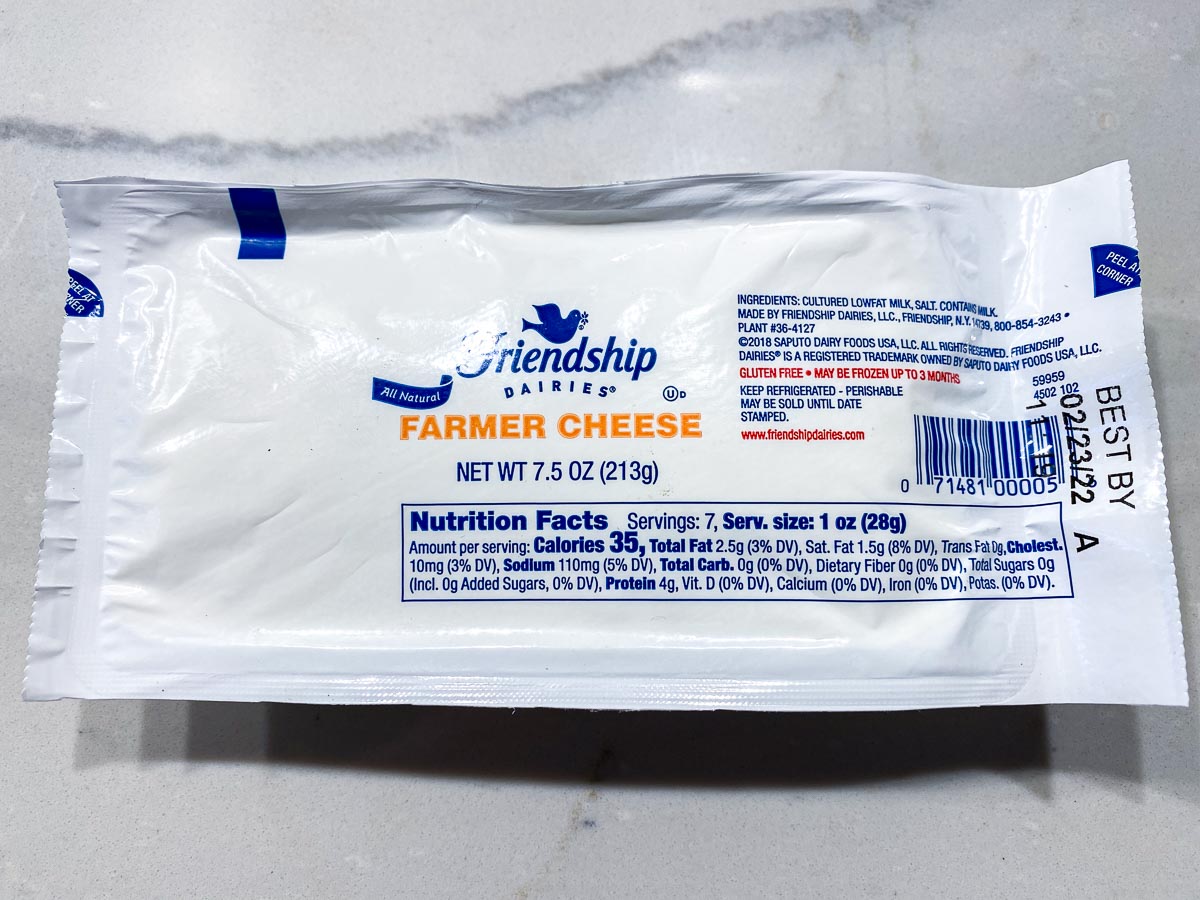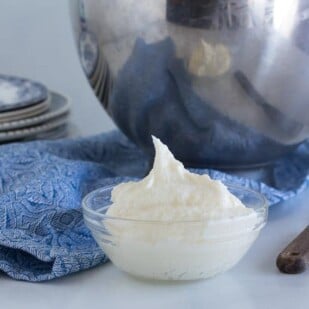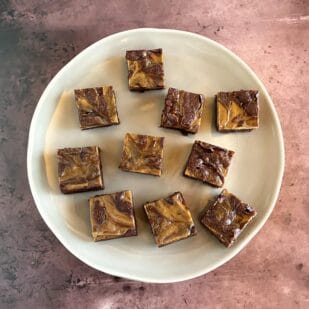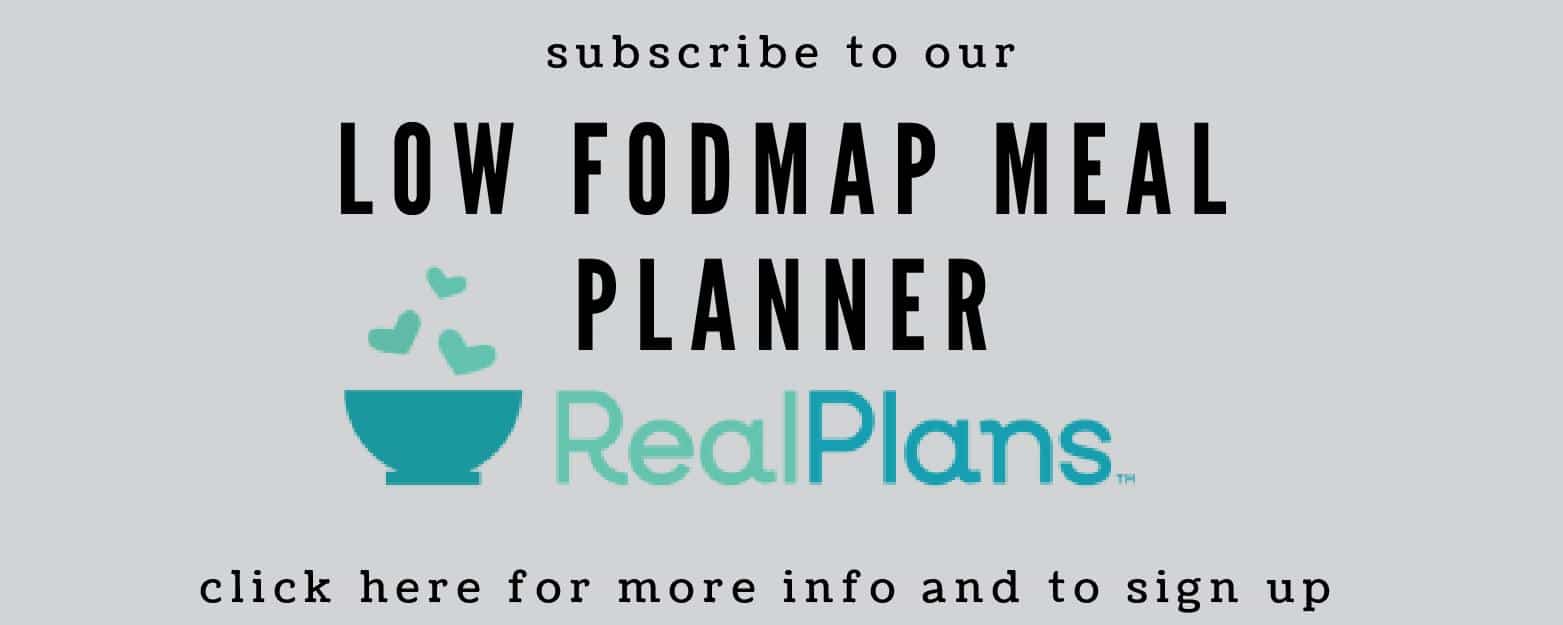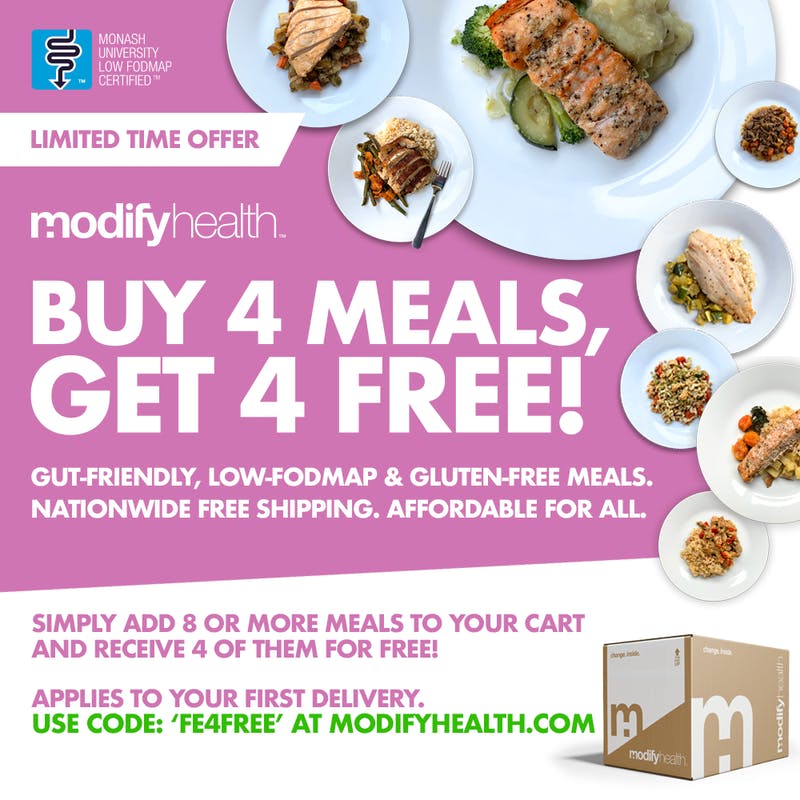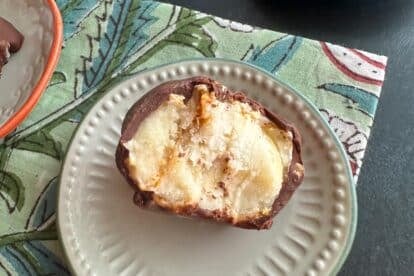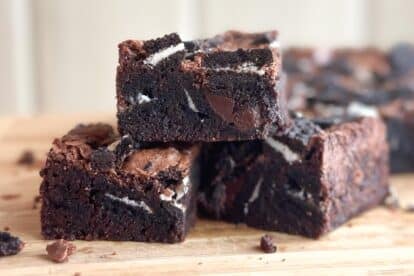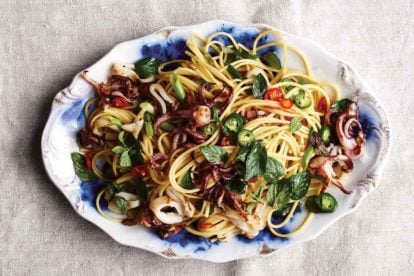Our Viennese Farmer Cheese Cake is sometimes referred to as Topfentorte. (The farmer cheese – often spelled “farmer’s cheese” – is “topfen”, a term also used to denote quark, another fresh cheese). This cheese cake is lighter than a NY-Style Cheesecake, features a pastry crust and flavors of citrus, almonds and plump, chewy raisins.
Various versions abound, but this one is low FODMAP, using lactose-free dairy and sports a gluten-free pastry crust. You might need to source the farmer cheese before you head out to the market, so plan accordingly. Note that you do need a 9-inch (23 cm) springform pan and the cake is best chilled overnight before serving.
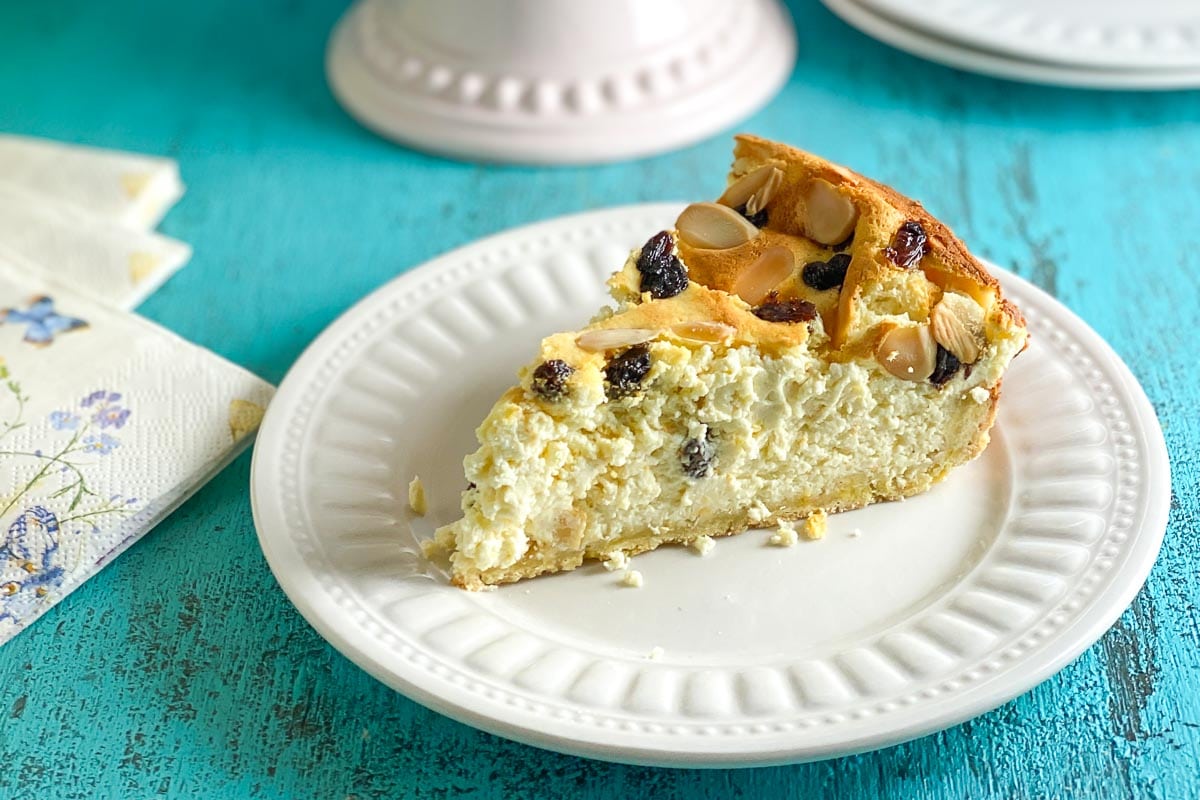
Some recipes for Topfentorte sport two layers of sponge cake with a sweetened cheese filling in-between. Our version is more akin to what you might know of as “cheesecake”, with a crisp crust and thick, creamy filling.
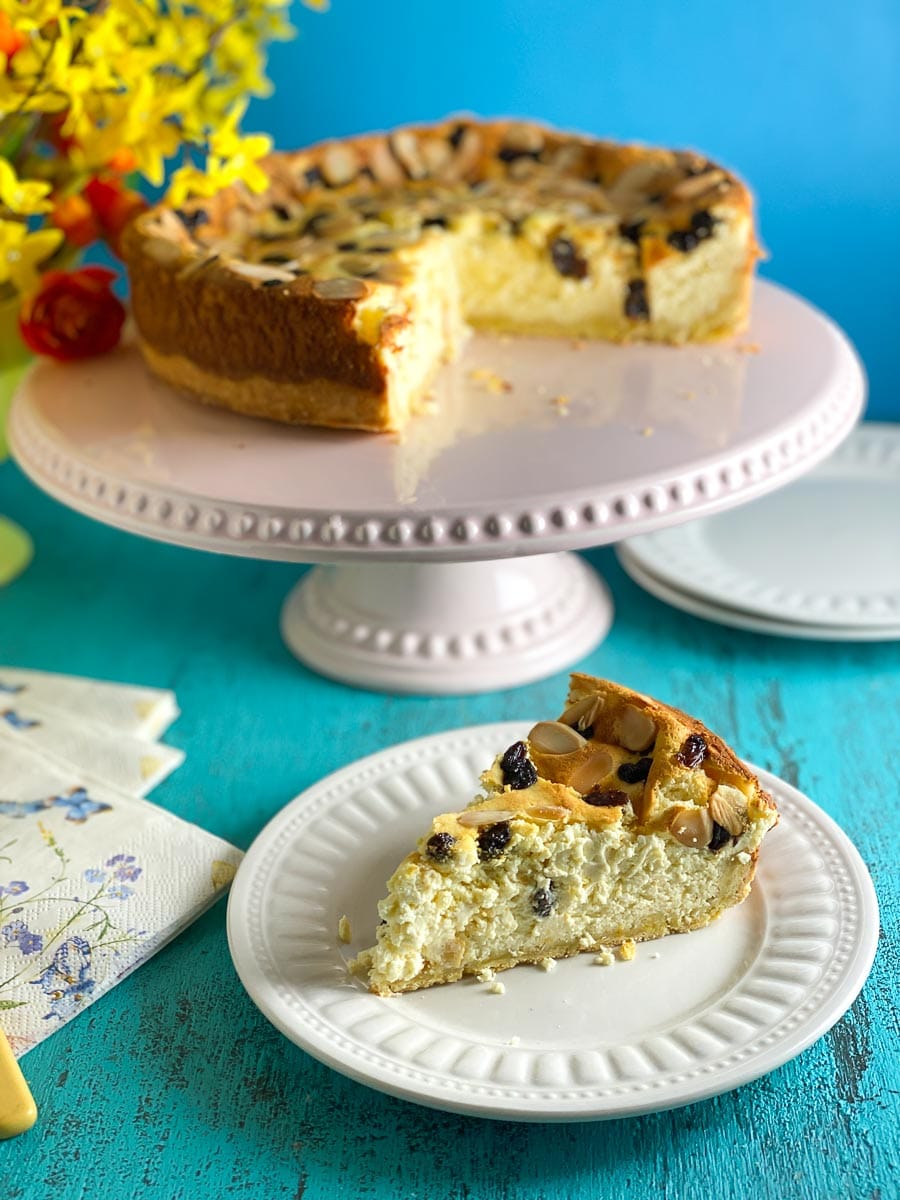
Eastern European Baking & Desserts
When it comes to anything involving Eastern European baking, I turn to my friend and expert Rick Rodgers. If coffee eclairs, sweet dumplings, cheese-filled crepes, Salzburg Dessert Souffle and classic Sachertorte are your thing (and why wouldn’t they be?) you must get yourself a copy of Kaffeehaus: Exquisite Desserts from The Classic Cafes of Vienna, Budapest and Prague. While it is not a gluten-free or low FODMAP cookbook, inspiration abounds, and you can find tons of recipes to re-create as desired.
When I was looking for a farmer cheese style cake, I turned to Rick, and this cake was inspired by his version.
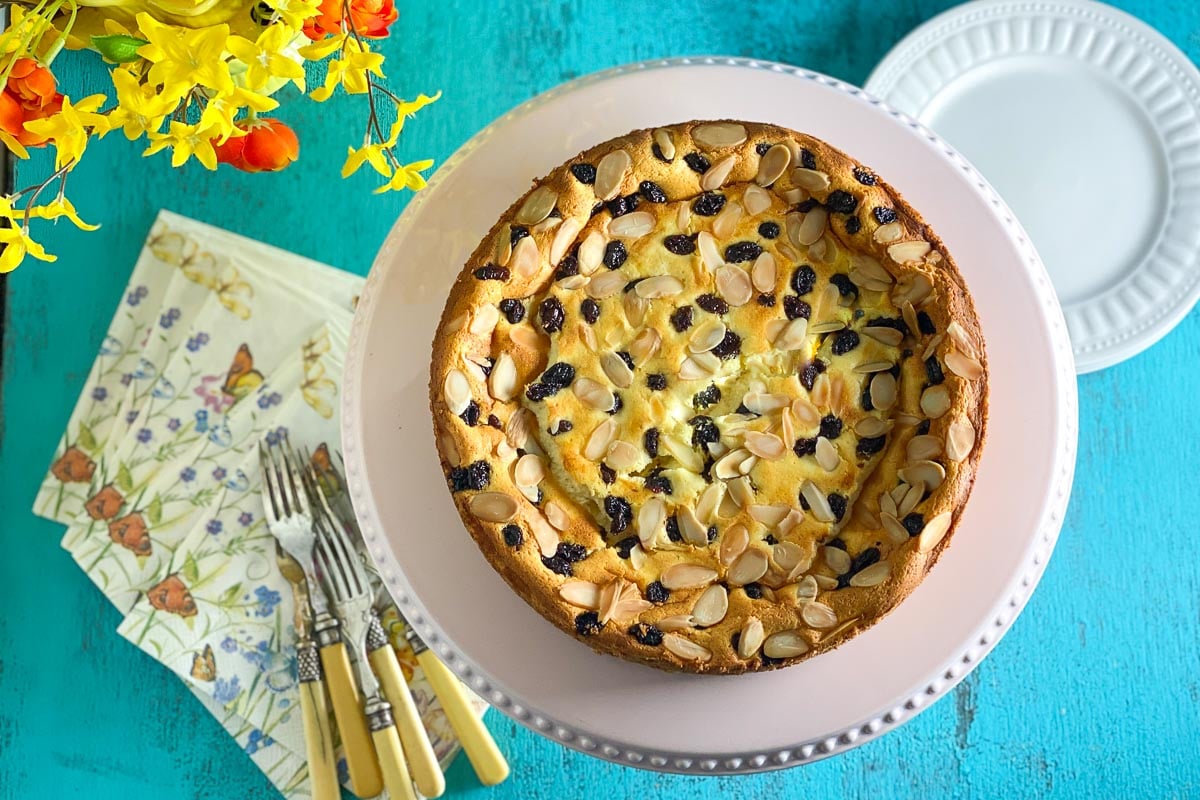
Frequently Asked Questions
There are various styles of farmer cheese and I’d like to point out the American-style, the European-style and the Amish-style. They do differ in flavor and texture and what is used to develop one recipe does not necessarily mean you can substitute another – even if the label says, “farmer’s cheese”.
The European style is very popular in Germany, Russia, Poland, the Czech Republic, Latvia, among other countries and regions.
The American and European style farmer cheeses are similar in that they are set with an acid; the resulting soured milk coagulates. For the American style the mixture is separated into curds, drained and pressed. The European style is made from simply ladling the soured milk into draining/straining sacks, yielding a very creamy texture. Both taste very bright and fresh with a gentle tartness.
They can be used in savory or sweet recipes, or simply spread on toast with jam or honey. Some aficionados eat it like one would eat yogurt.
The Amish type is firm and more akin to a Monterey Jack cheese and would not work in this recipe at all.
As with any cheese, check the label! Our article Is Cheese Low FODMAP? teaches you how to tell if any cheese is low FODMAP. I use Friendship Farmer Cheese for this recipe, which you can see contains 0% carbohydrates or sugars. No carbs, no FODMAPs!
Look at the label below under Total Carb. Note the 0%. This is the Friendship brand Farmer Cheese label; I recommend it for this recipe.
FODMAP confusion swirls around raisins. The poor maligned dried fruit! They have a big, scary Red Light next to them in the Monash University smartphone app, designating that they can be high FODMAP. But, if you look more closely, and open the app entry, you will see that they have a Green Light low FODMAP serving size of 1 Australian tablespoon or 13 g.
As with any low FODMAP recipe you have to look at the entire amount of ingredients used, divided into serving sizes (and also, take Stacking into account). This entire recipe uses ¼ cup (52 g) of raisins, yet the cake serves 14.
PS: The original recipe called for golden raisins, which have a very different flavor, and of course would give the cake a very different look, but they have not been lab tested for FODMAPs, so we use dark raisins, which have been lab tested.
Almonds have a low FODMAP serving size of 12 g. Our recipe contains a total of 22 g, but our recipe serves 14, so our serving size is well within low FODMAP designations. You might want to review our article, What Is A Low FODMAP Serving Size?
Almonds come is all shapes and sizes. Whole, sliced, slivered and all of those “shapes” can come in natural (skin on) and blanched (skin removed). This recipe calls for blanched and sliced. This type of almond will give you the best visual, texture and flavor. If you must make a substitute, I would suggest sliced natural (skin on) almonds. Natural almonds tend to be drier and can affect recipes, especially in baking recipes, but they would be the best substitution in this case.
Ingredients
Here are our crust ingredients. We use Bob’s Red Mill 1 to 1 Gluten Free Baking Flour, which contains xanthan gum, but we also ask that you use additional. It helps create a better crust texture.
Xanthan gum, by the way, is low FODMAP; we have an article for you discussing xanthan gum and guar gum, here.
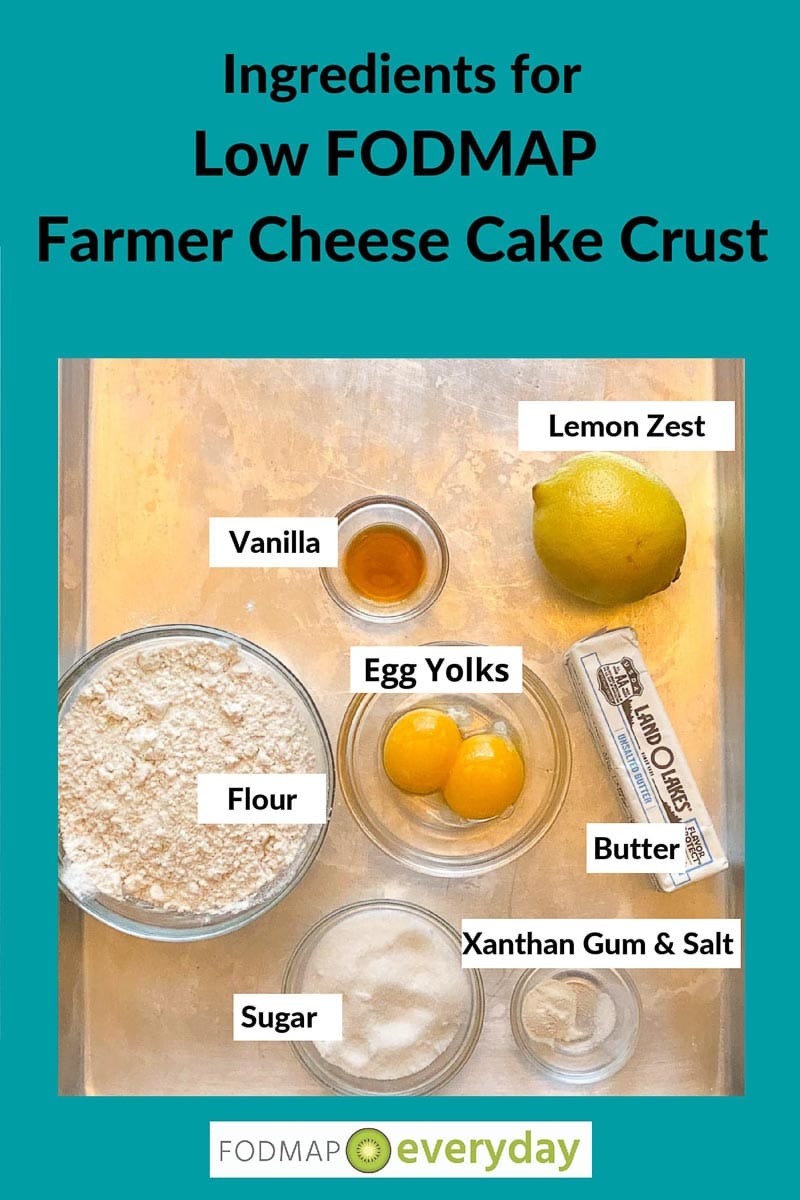
Here are the filling ingredients:
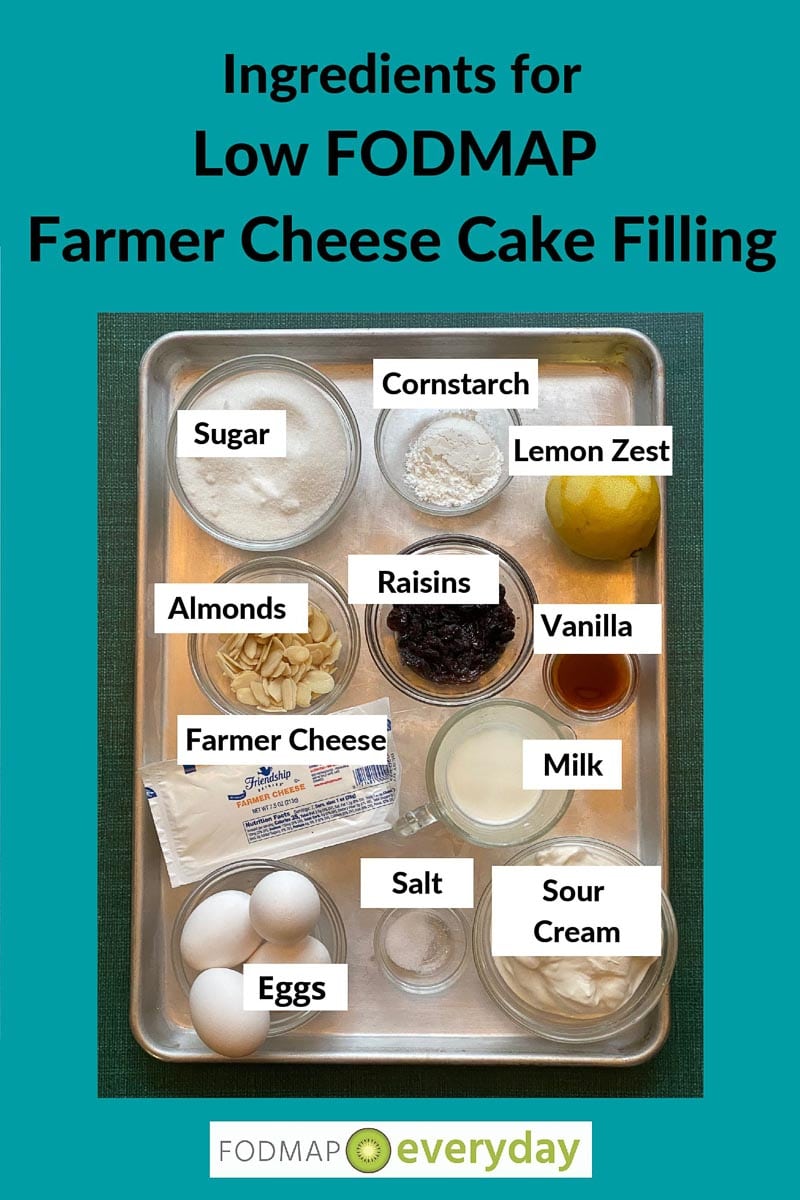
The farmer cheese is the one item you may have not purchased before, so make sure your local stores have it before planning to make this cake. It is easy to find in our regular supermarkets. Check the label. It should say 0% carbs and I suggest Friendship brand, if possible, as that is what was used when developing this recipe and will provide great results (see label image above).
Raisins
You will note that the ingredients call for “plump” raisins. It might sound like an oxymoron but when it comes to dried fruit, you want it to be fresh and plump. If your raisins are dried, tough and shriveled, you can add 1 ½ tablespoons of water and heat them gently in a saucepan (bring to a simmer, then turn off heat) or zap in the microwave for abut 20 seconds.
As an option, you can plump in Grand Marnier, or our Low FODMAP Orange Liqueur. If you go for this option (I always do), then also add the optional orange zest listed in both the crust component as well as the filling.
Milk
Rick’s original recipe included ¼ cup (60 ml) of milk. It is included in the Ingredient photo, however, on one of my tests I forgot to add it, and I think I liked the results even better! Your choice.
How To Make Our Cheese Cake
Let’s first talk about the pan prep.
Using Your Springform Pan
If you click on over to our NY Style Low FODMAP Cheesecake you will see that the cheesecake and its crust are formed directly on the metal bottom of the springform pan – and indeed, this is how most folks make cheesecake.
But it does not create the nicest looking finished dish. Plus, if you take the cheesecake somewhere to share, there is a high chance of leaving that metal bottom behind; been there, done that.
There is a way to assemble your cheesecake and crust in such a way that when you unmold the cake from the springform pan, you can remove the sides and then also separate the cake from the pan bottom. This allows you to place your cheesecake directly on a lovely platter of your choice.
It is all in the pan prep.
Lining Your Springform Pan With Parchment
Parchment paper stars in this particular technique. For our Low FODMAP Viennese Farmer Cheese Cake, follow these 3 steps:
1. Separate your springform pan pieces. Cut a piece of parchment paper a bit larger than the bottom of your springform pan. You want there to be overage; around 11 or 12-inches (28 to 30.5 cm) is good for our 9-inch (23 cm) pan.
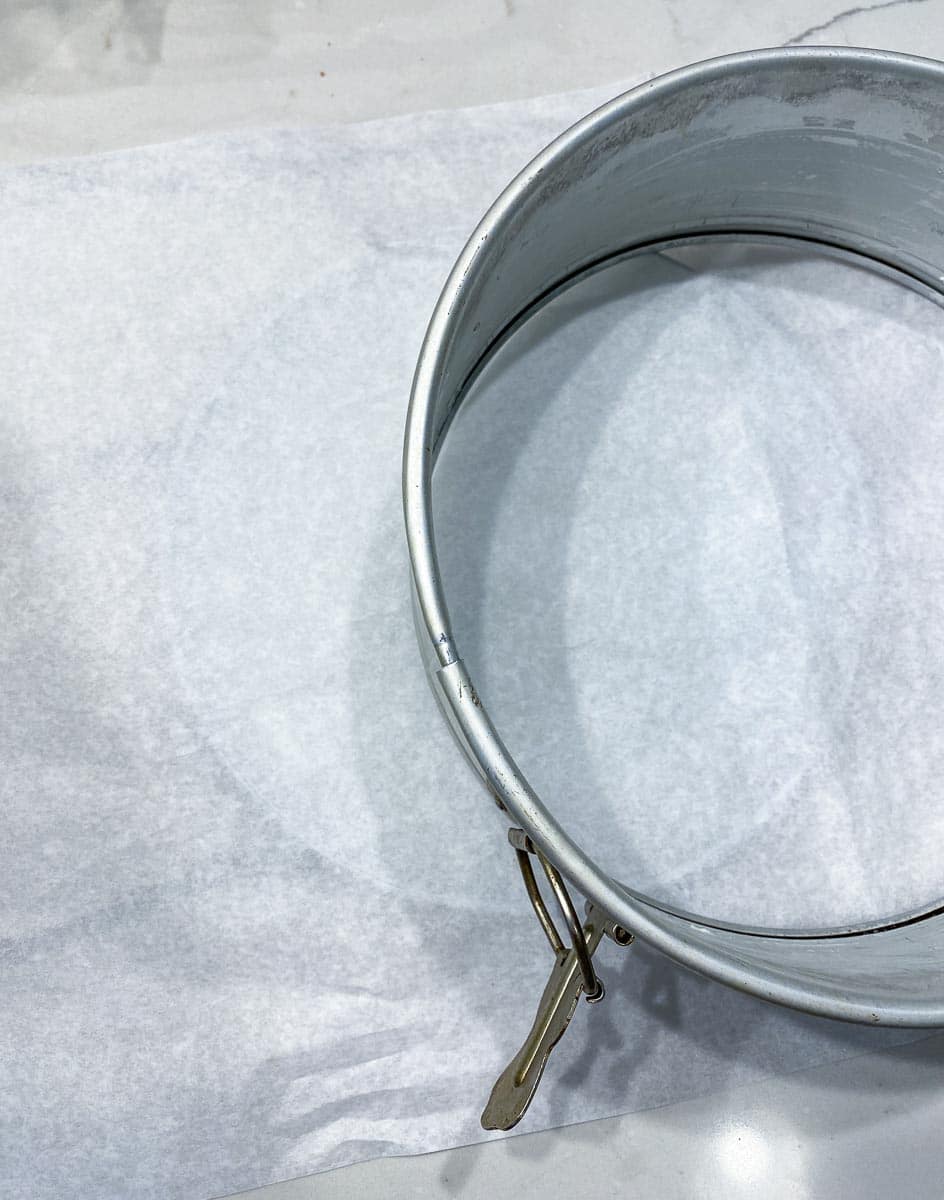
2. Center this parchment on top of the metal bottom of the springform pan. Snap the springform sides into place, with the bottom edges catching the parchment so that it is locked into place. You can trim the paper with scissors.
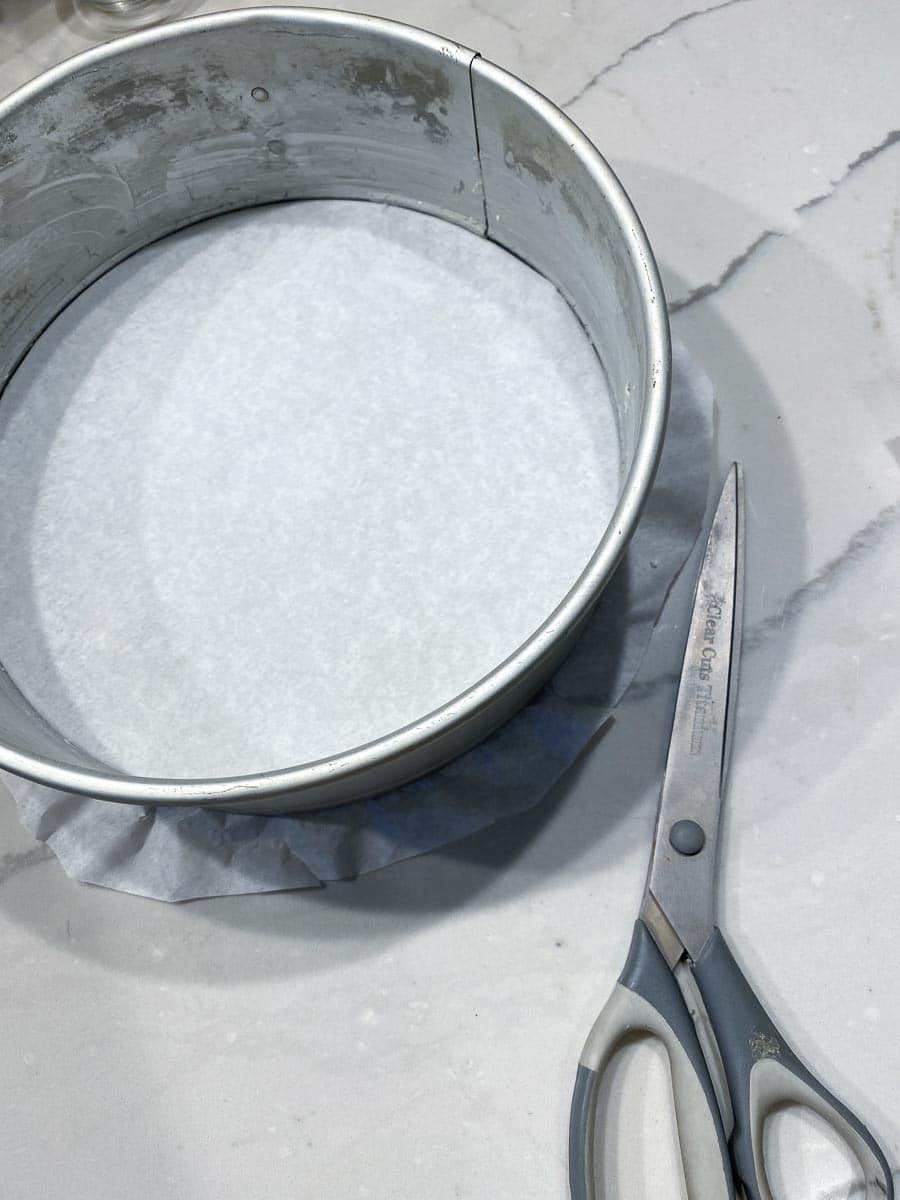
3. Now you are ready to butter the pan and parchment and you will be able to remove the entire cheesecake from all parts of the springform pan once chilled, allowing a more elegant final look.
For the Crust
Combine the flour, sugar, xanthan gum and salt in stand mixer bowl.

Using the flat paddle attachment, add the butter and mix on low-medium speed until the mixture resembles coarse crumbs.
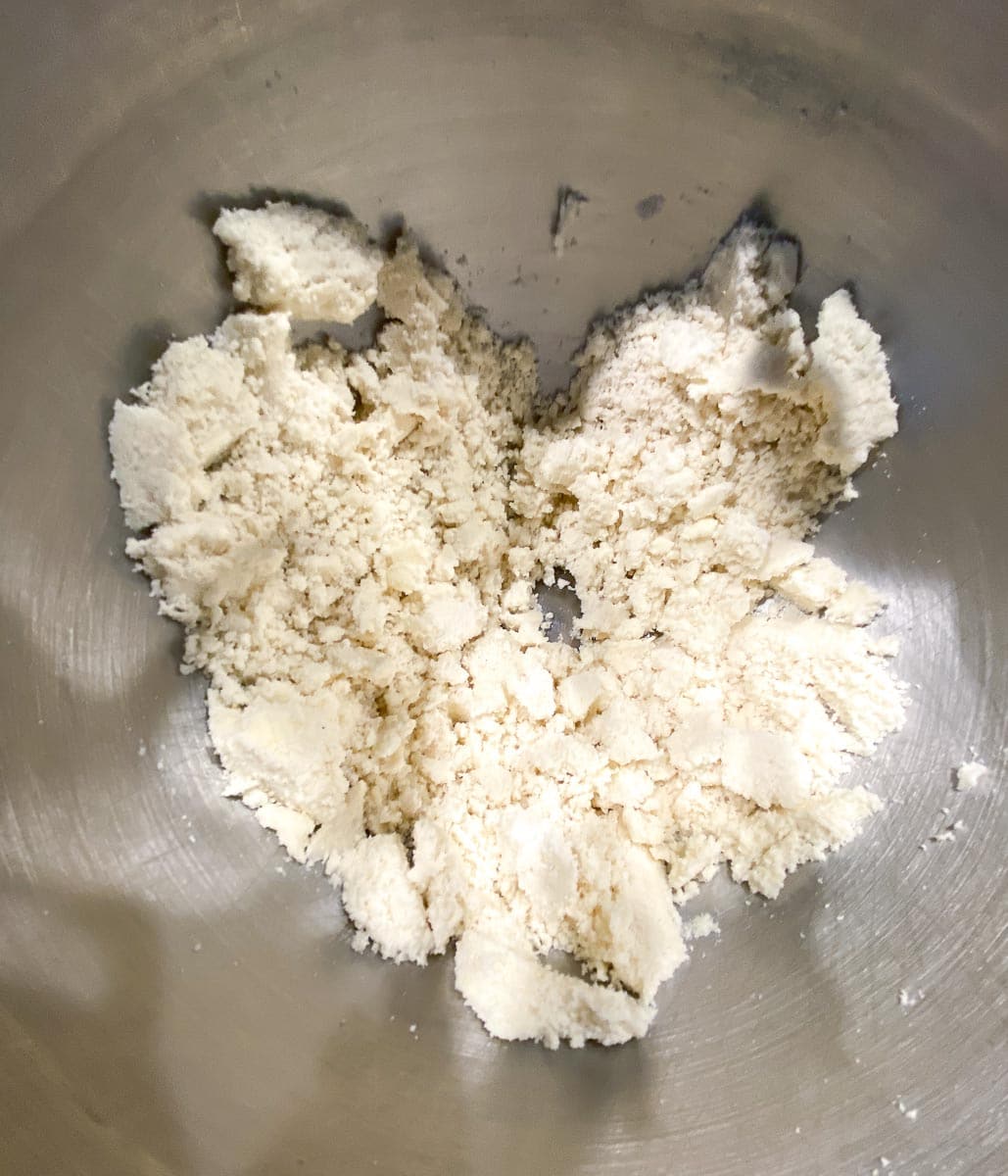
Whisk together the egg yolks, lemon zest, orange zest if using, and the vanilla extract.
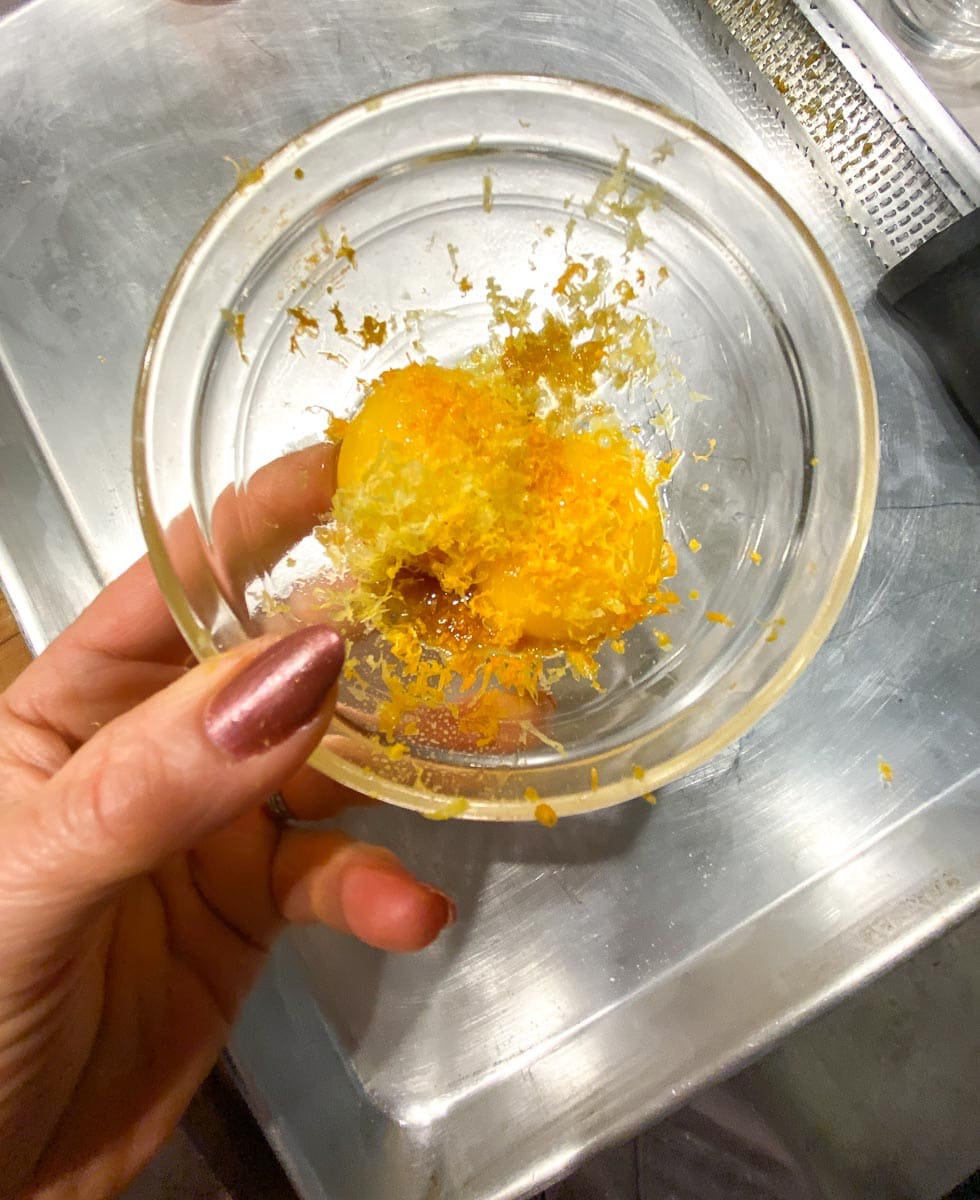
Add to the dry mixture. Mix until the dough is evenly moistened and holds together when pressed between your fingers.
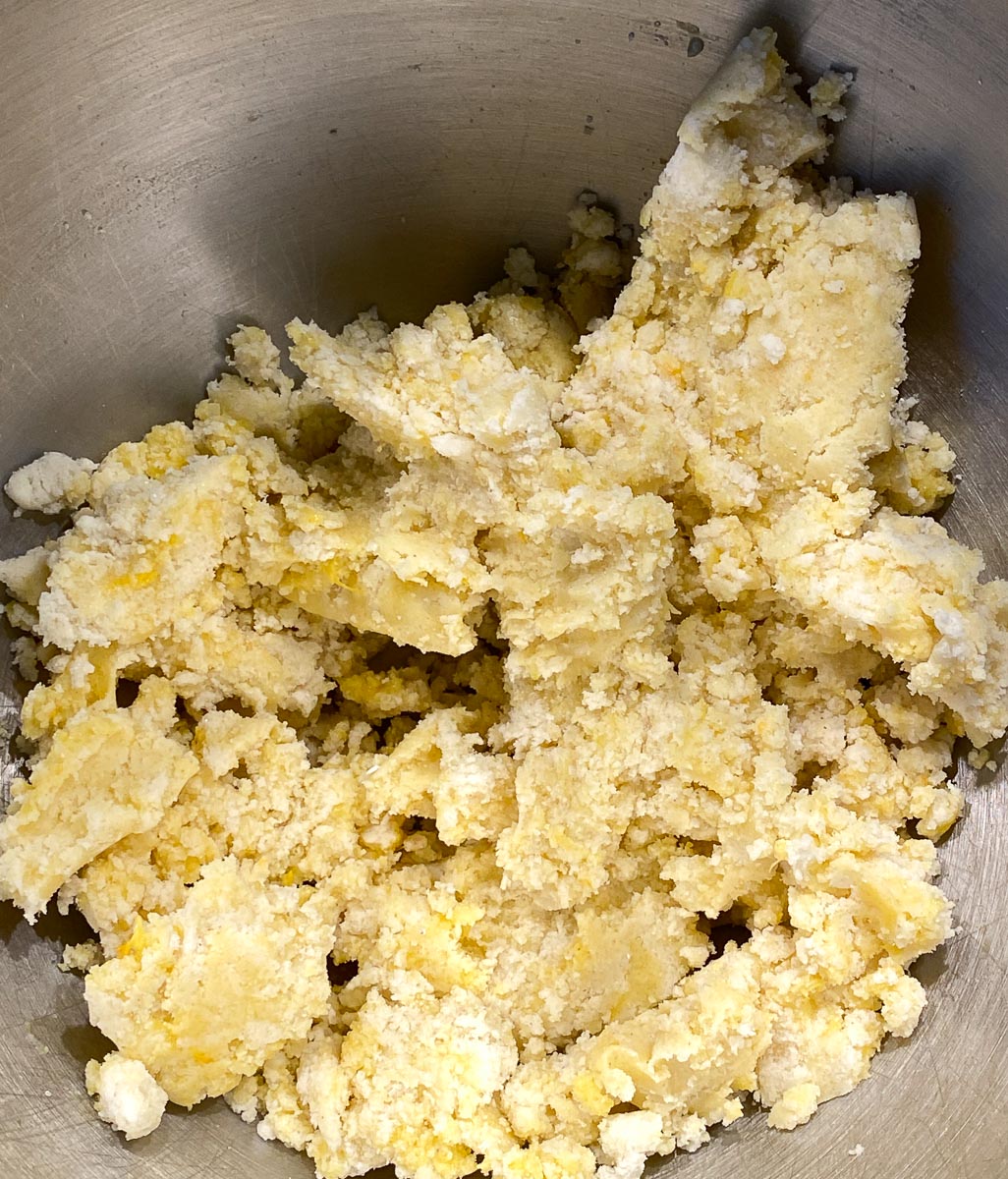
Gather together by hand, knead it a couple of times, press into a flat disc and wrap with plastic wrap. Refrigerate for about 30 minutes. You can also make this dough this by hand with a pastry-blender.
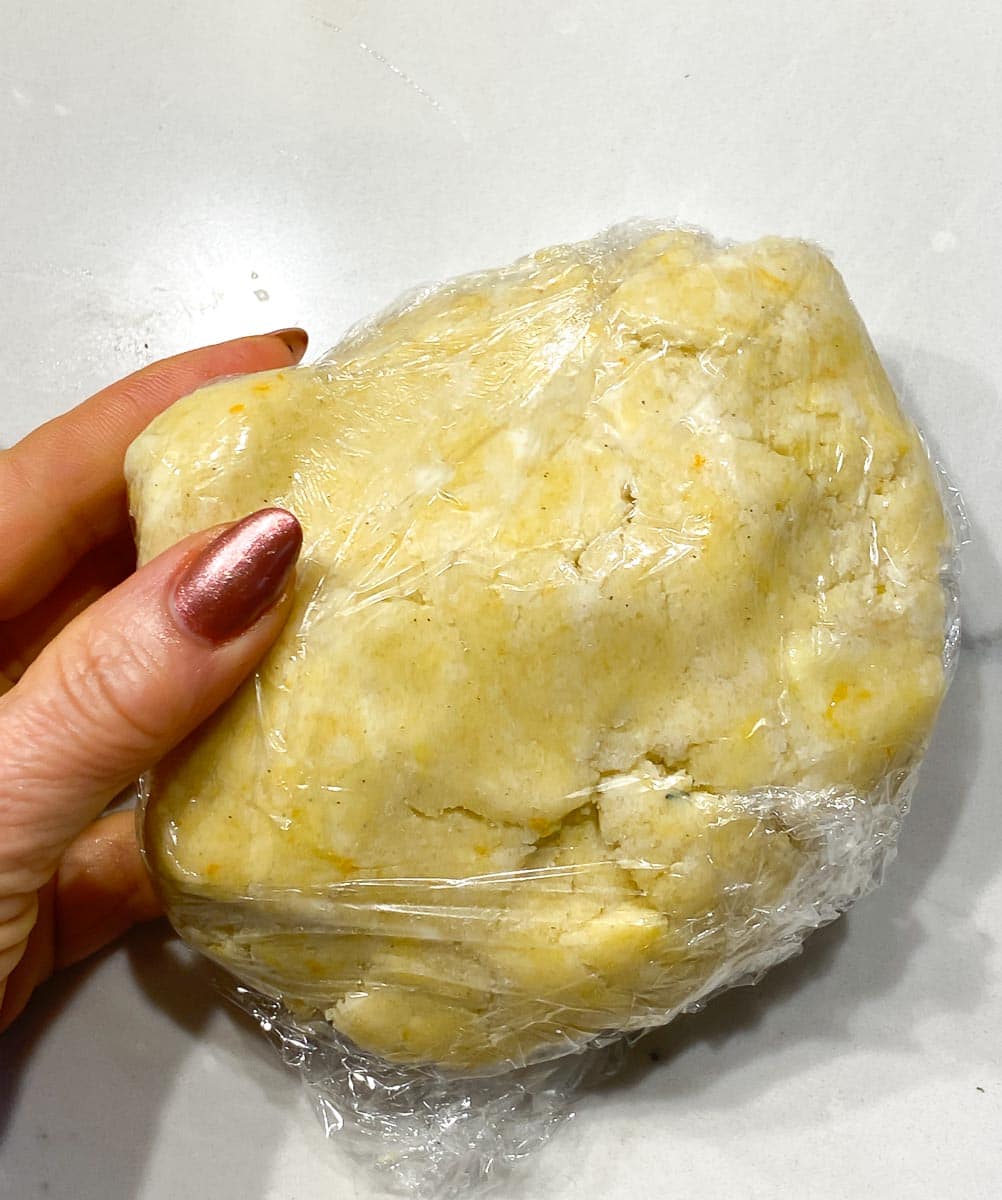
Position rack in center of oven. Preheat to 400°F (200°C). Line the bottom of a 9-inch (23 cm) springform pan with parchment paper as follows: Cut a piece of parchment larger than the pan’s bottom and place on top of pan bottom. Attach the springform sides so that they go over the paper and seal it into place as you snap the springform shut. The paper will overhang the exterior of the pan; that’s what you want. This will allow you to remove the cake from the pan bottom easily, to place on your serving platter.
Lightly butter the insides of the pan, both the parchment and pan’s sides. Press the dough firmly and evenly into the pan, bringing the dough about 1-inch (2.5 cm) up the sides.
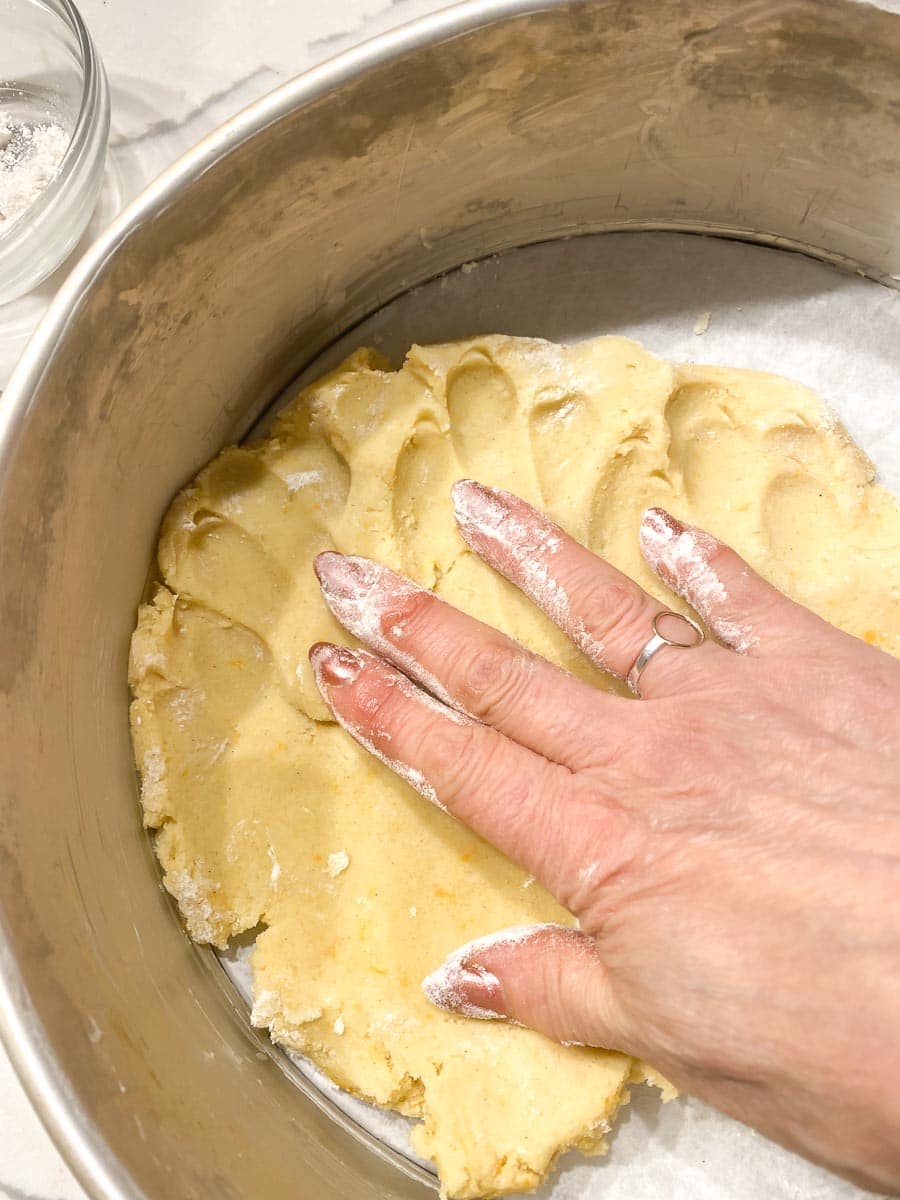
Pierce the dough all over with a fork and freeze for 10 minutes.
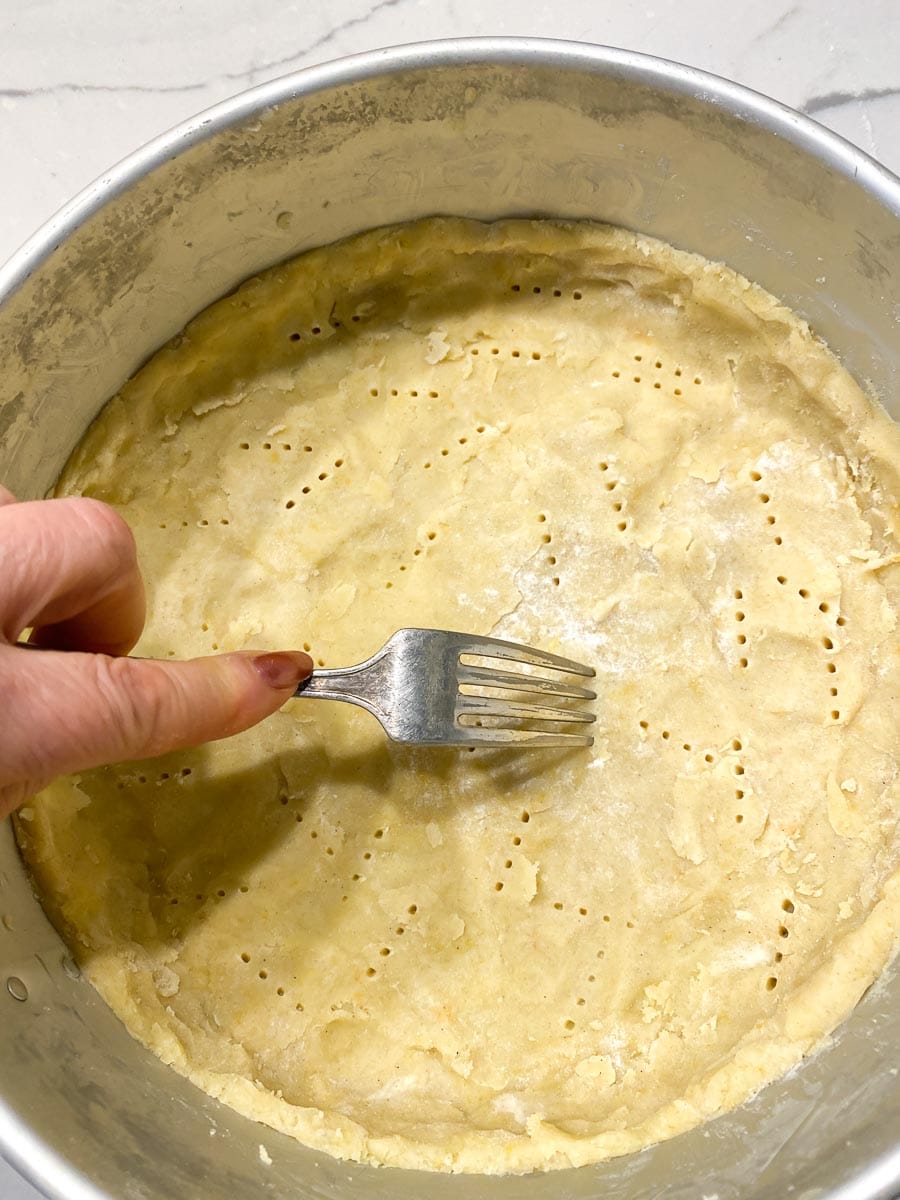
Bake for about 10 to 12 minutes or until the crust is just beginning to brown. Place on a wire rack and cool completely.
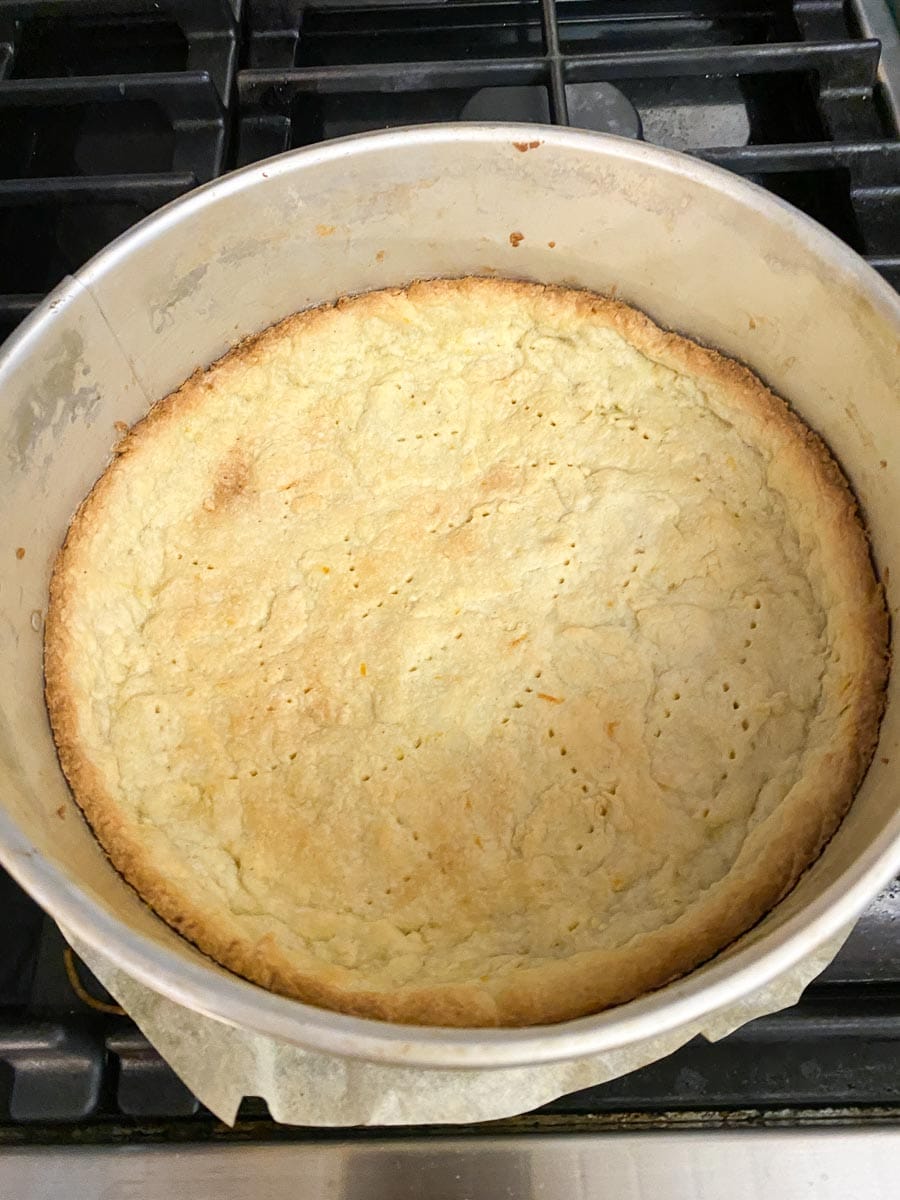
For the Filling
Place the farmer cheese in your stand mixer bowl, fitted with flat paddle attachment.
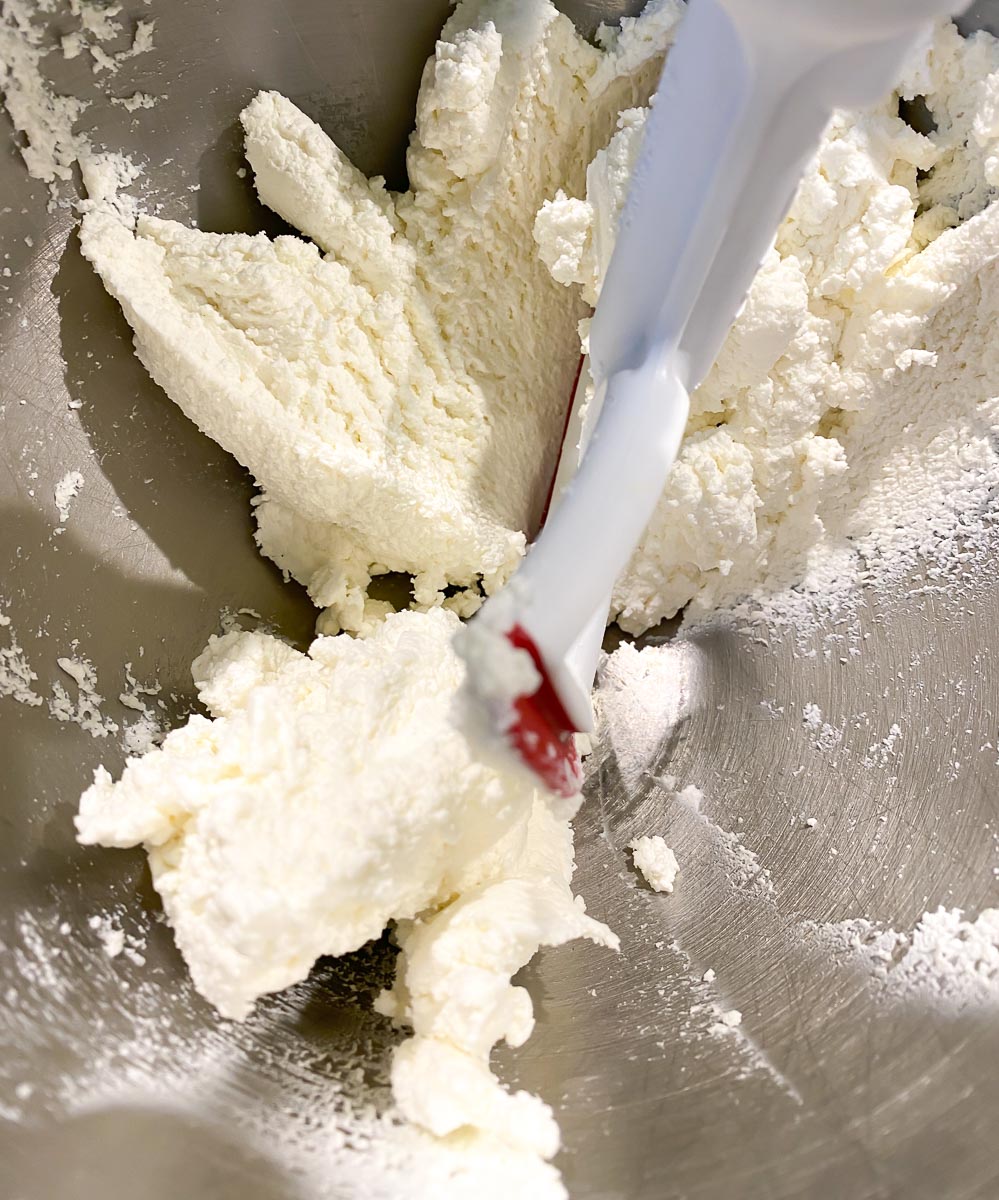
Beat on medium speed for about 30 seconds; you want to smooth it out a bit. Add the sour cream, ¼ cup (50 g) of the sugar, milk (if using), cornstarch, vanilla, lemon zest, orange zest (if using), and salt and beat on low-medium speed until combined. Beat in the 4 egg yolks, one at a time; do not overmix.
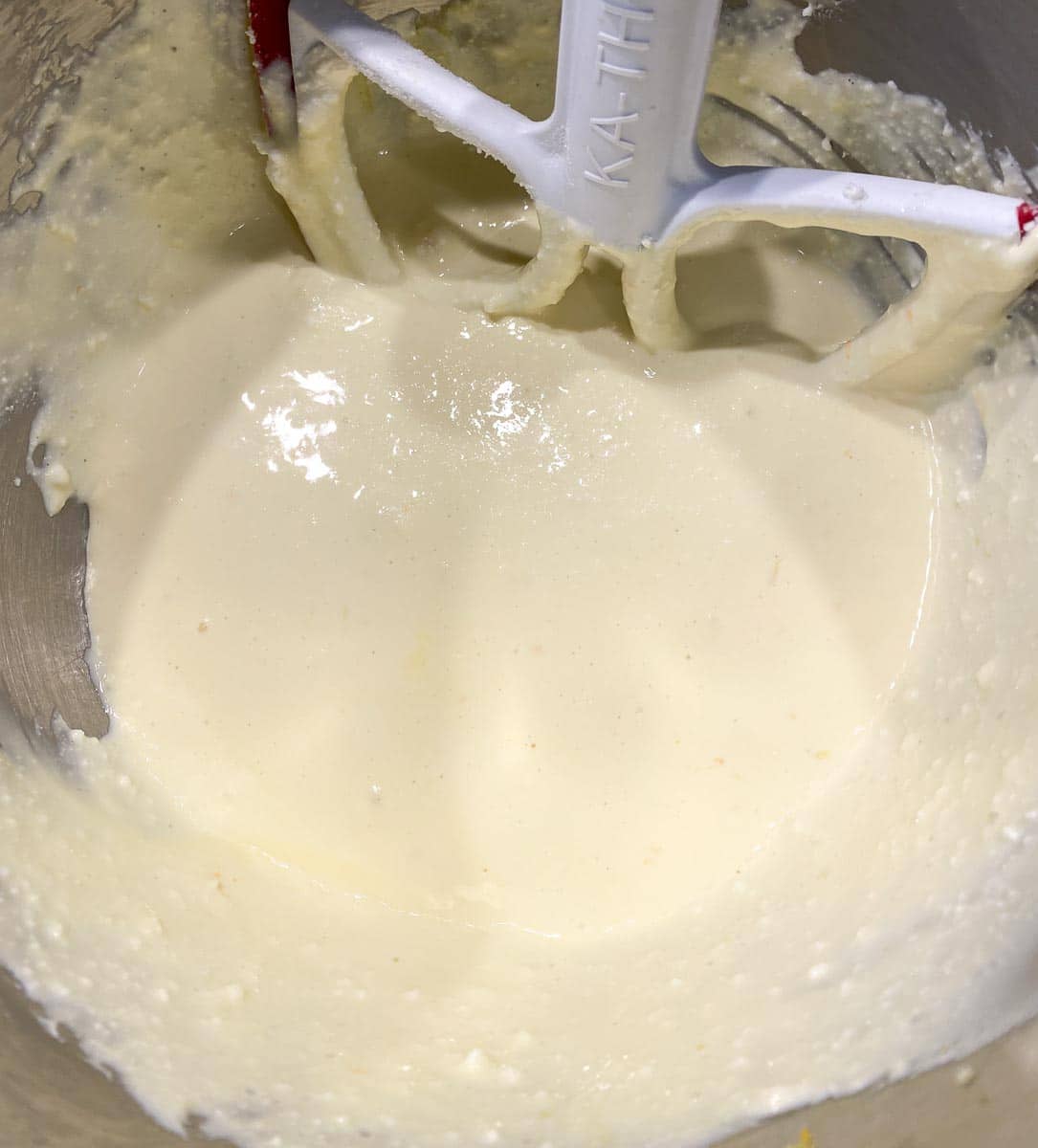
You want the batter to blended, but not to incorporate too much air, which could lead to excess expansion during baking, subsequent deflation and more chances of cracks forming.
Place egg whites in a clean, grease-free mixer bowl and beat with balloon whisk attachment on high speed until soft peaks form.
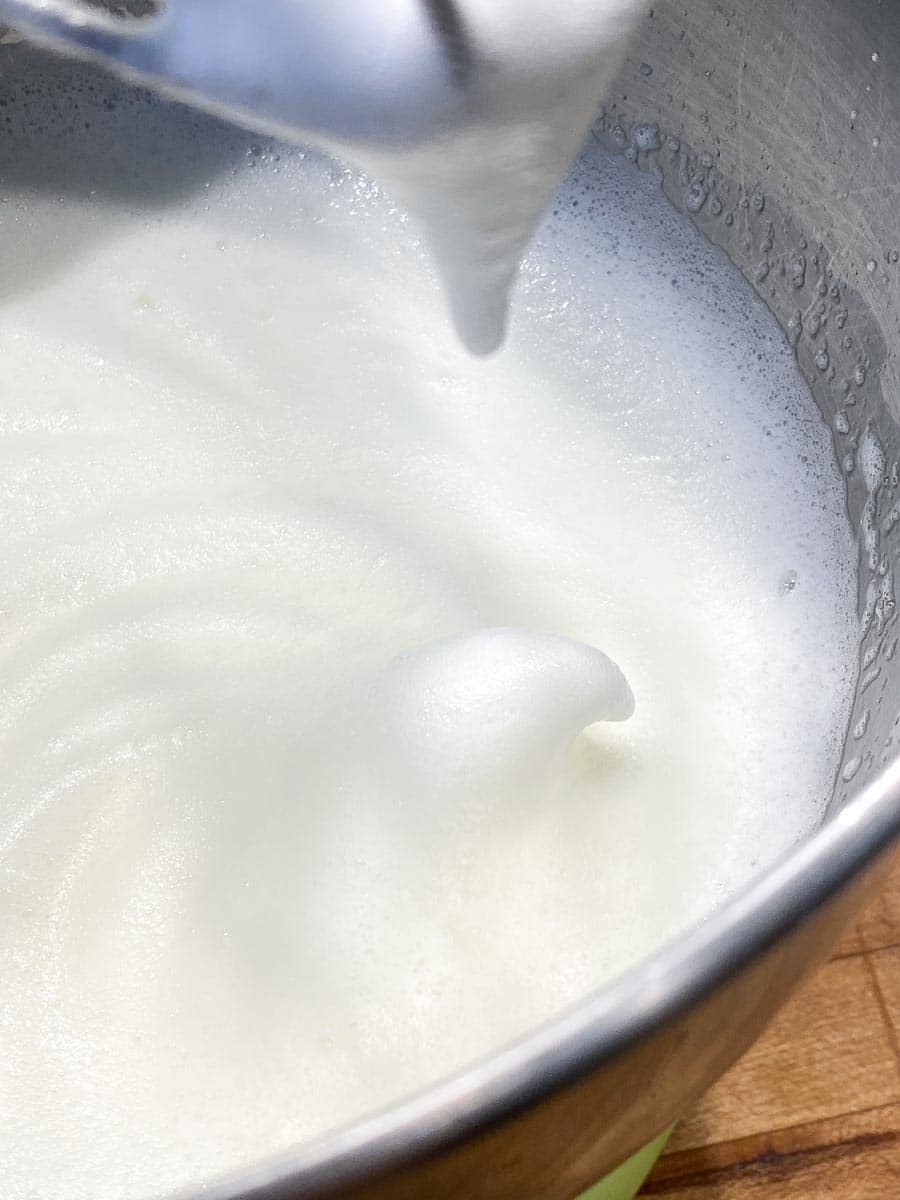
Gradually add remaining ½ cup (99 g) of the sugar and beat until the egg whites form stiff, shiny peaks.
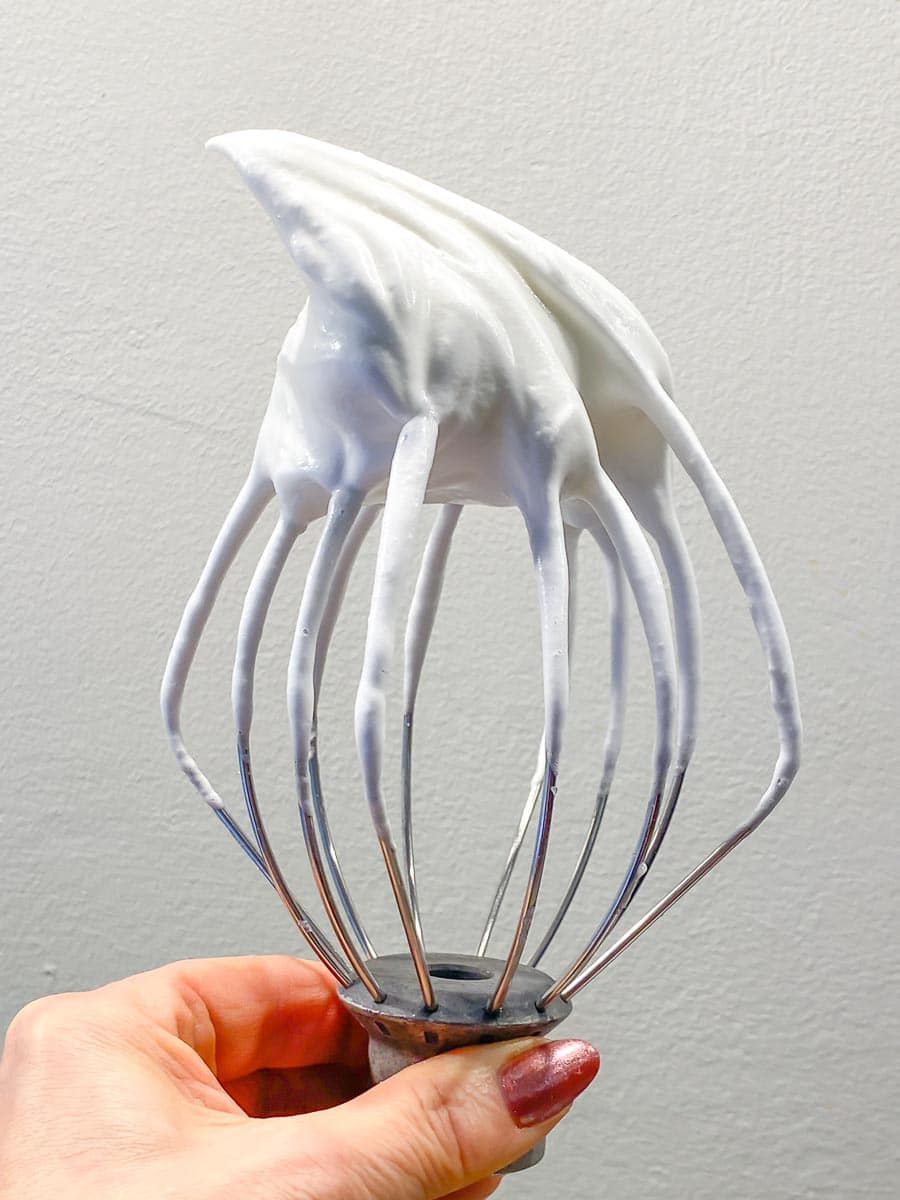
Stir about a quarter of the whites into the cheese cake mixture to lighten, then fold in the rest.
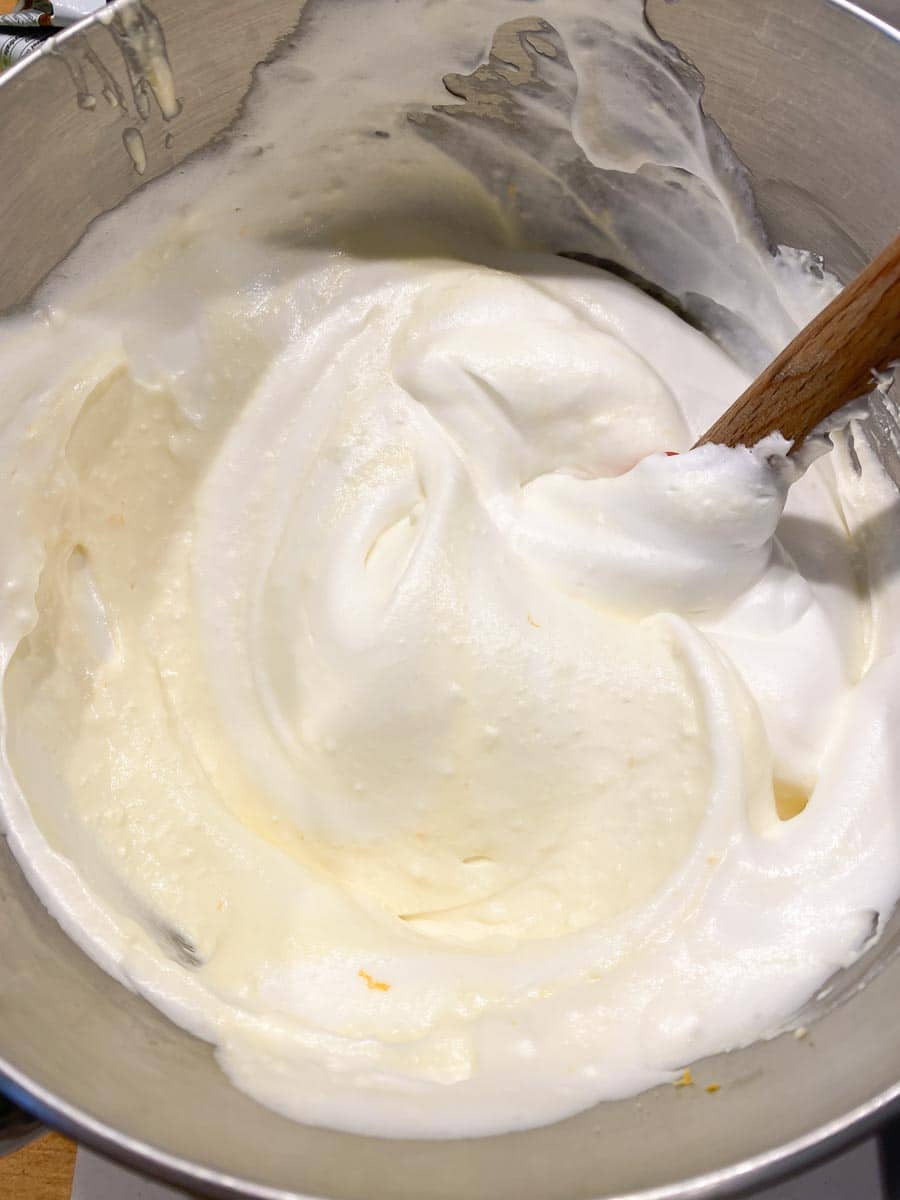
Pour the filling into the cooled crust and even out the top with a small offset spatula.
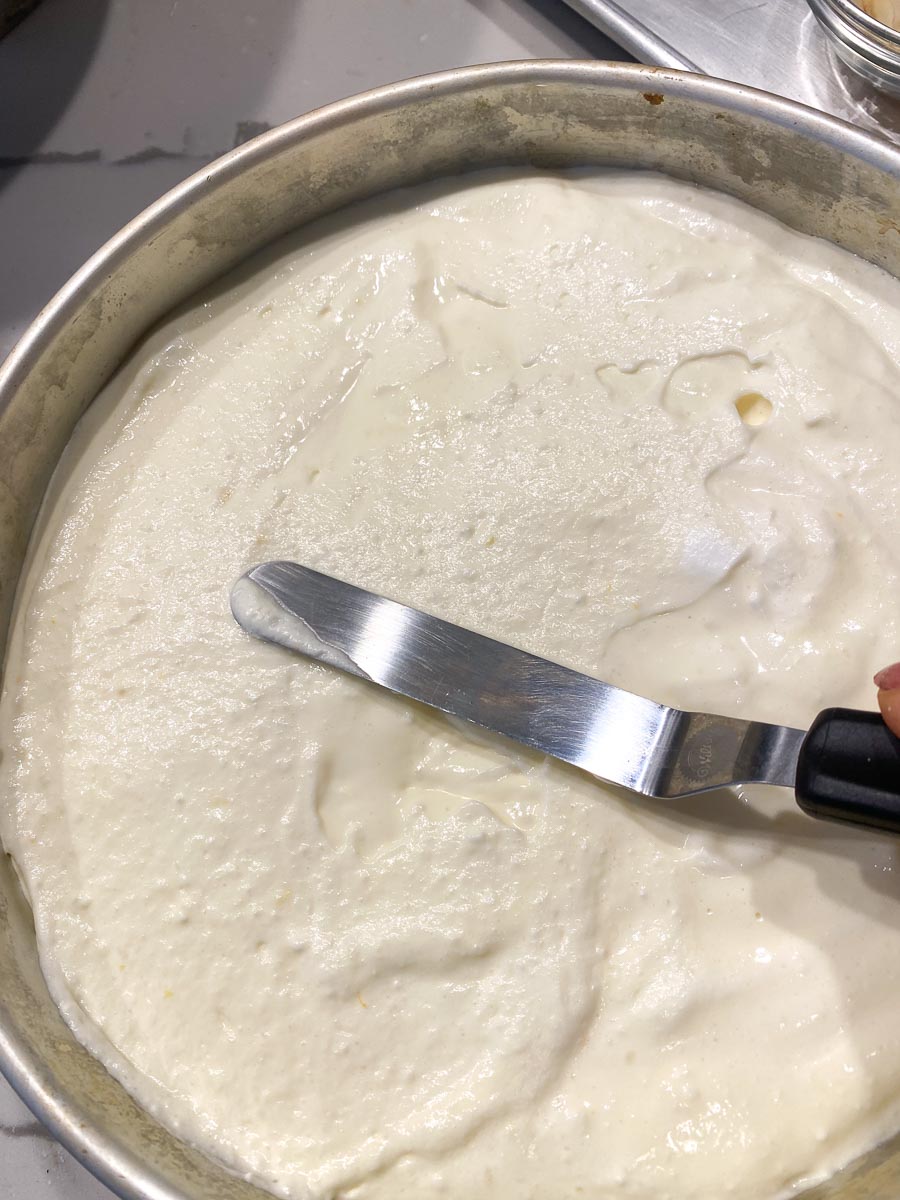
Sprinkle the raisins (drained of any liquid) and almonds evenly over the top.
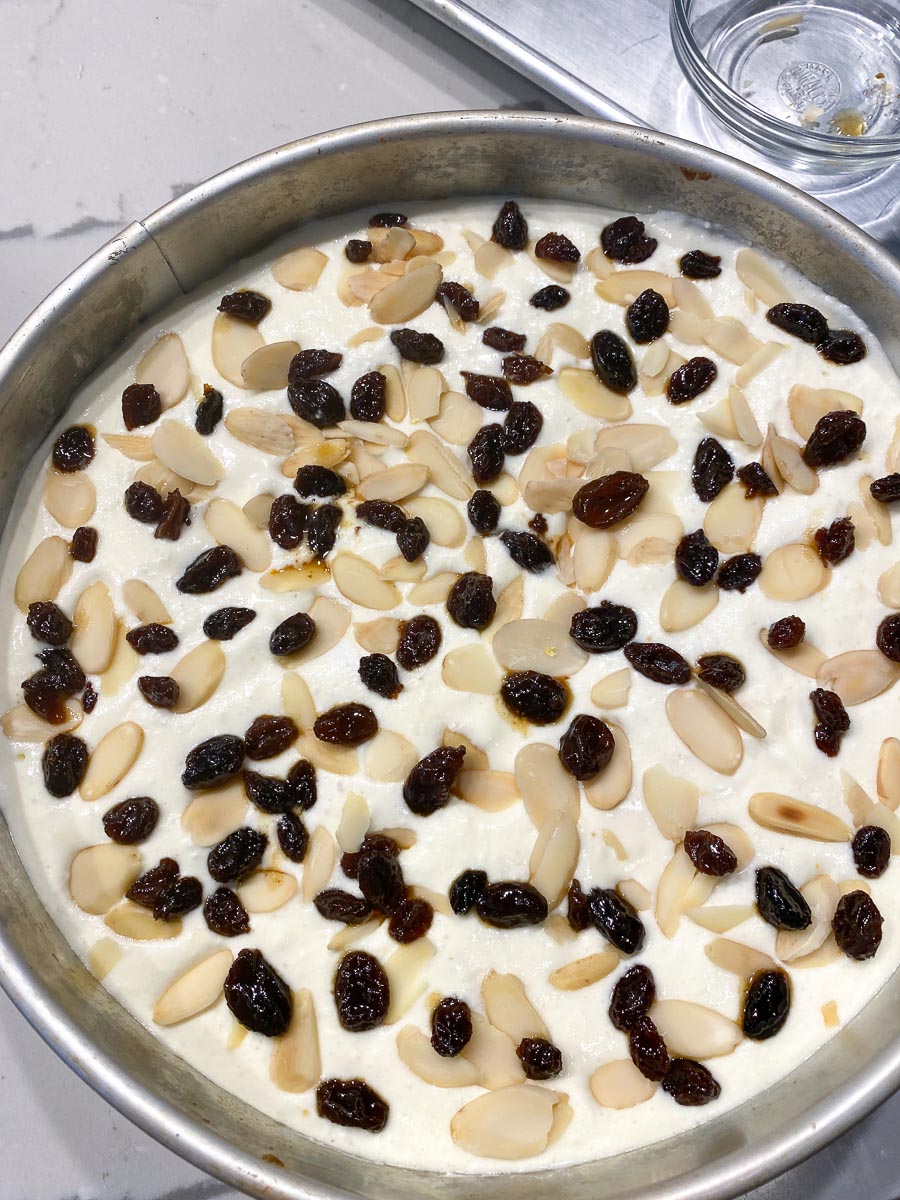
Bake for 10 minutes at 400°F (200°C), then reduce the oven temperature to 350°F (180°C) and bake for about 20 to 30 minutes more or until the edges of the filling are gently puffed and barely tinged with golden brown. The center will still be wobbly; it will firm up upon cooling. Do not overbake, which might encourage cracking.
Remove from the oven and place on a cooling to and cool completely. Cover the top with plastic wrap and refrigerate overnight or up to 2 days. To unmold, run a small, straight icing spatula under warm water and use it to completely separate the cake from the pan, pressing out towards the pan.
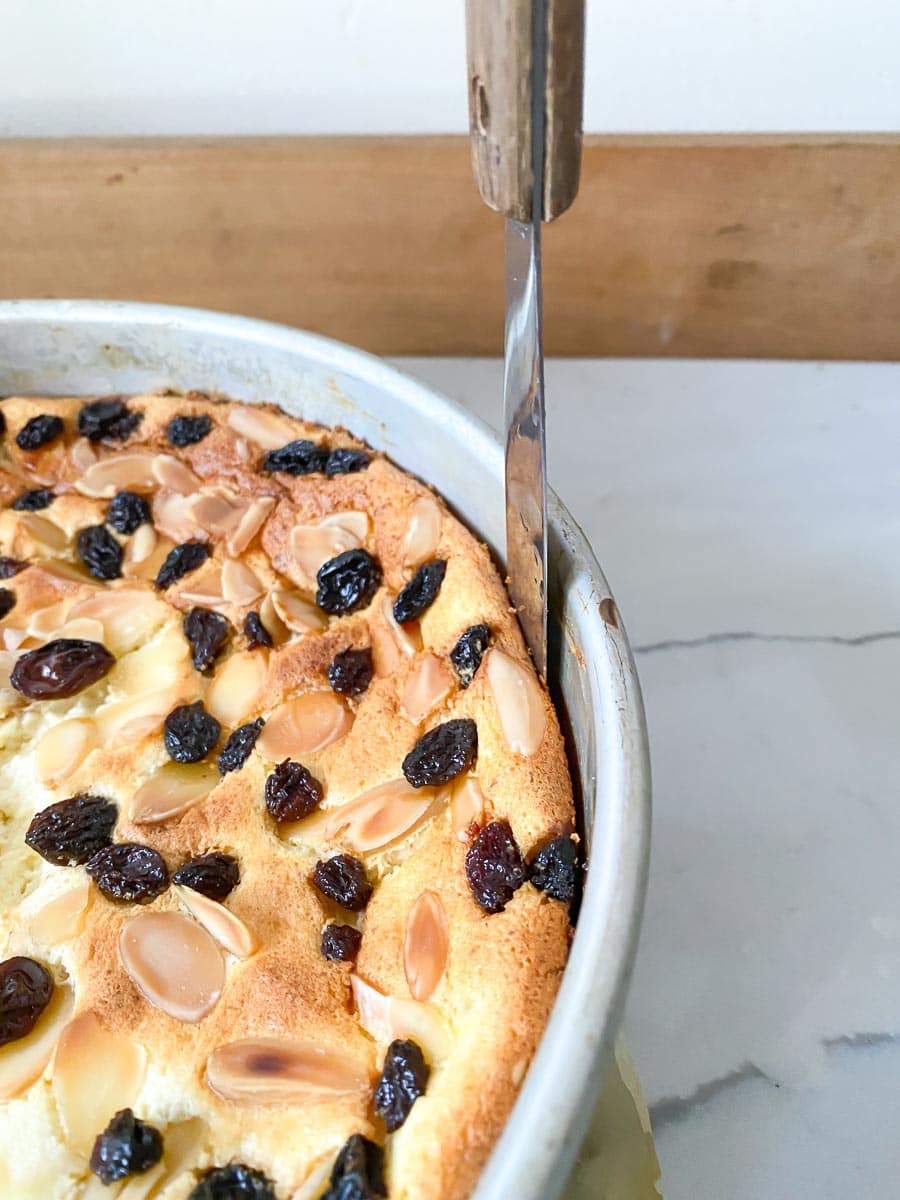
Remove springform sides. Now take a cake lifter, loose bottom tart pan bottom or broad flat spatula and separate the pastry crust from the parchment.
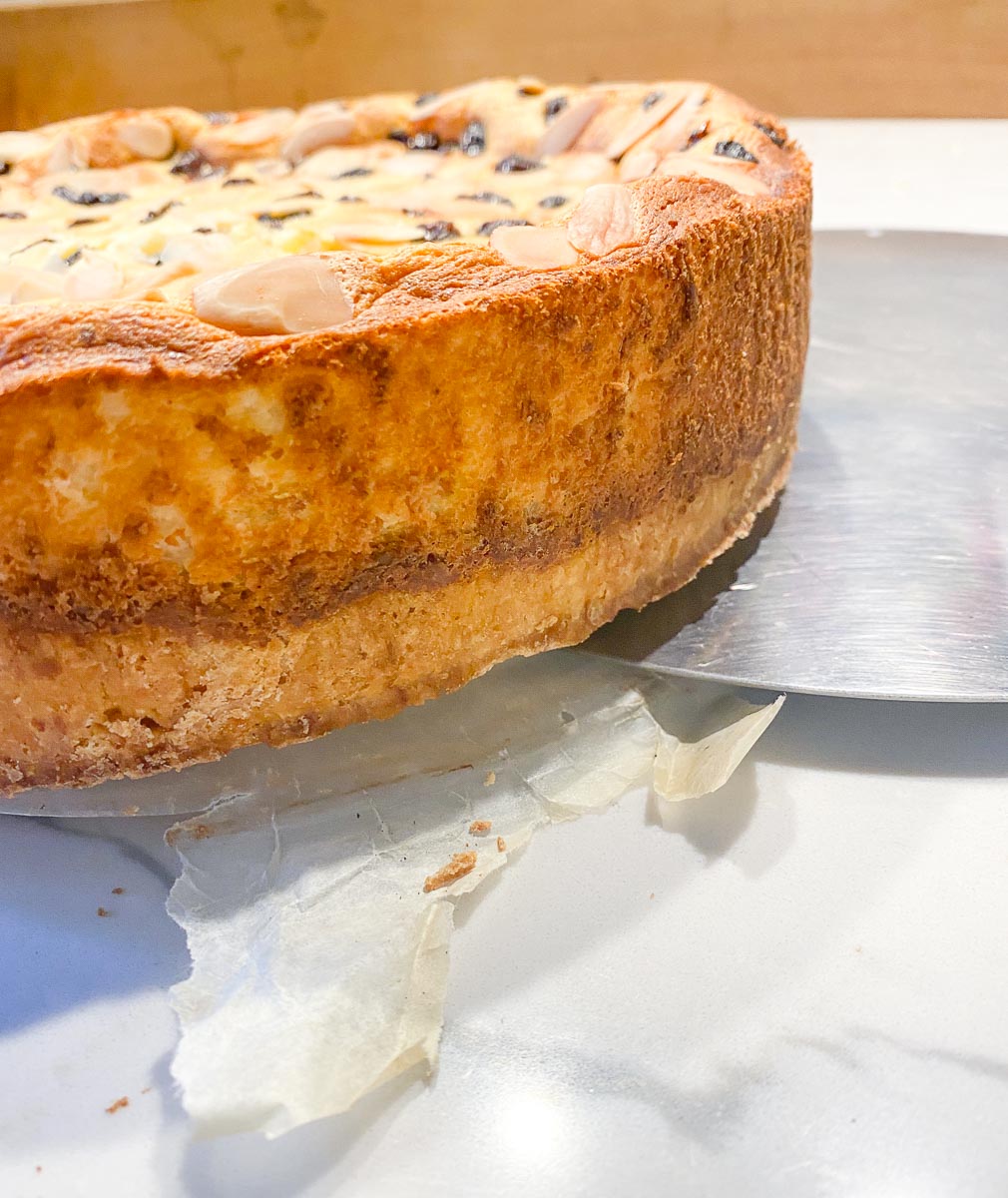
Lift cake up and away from parchment, peel away parchment, and place cake on serving platter.
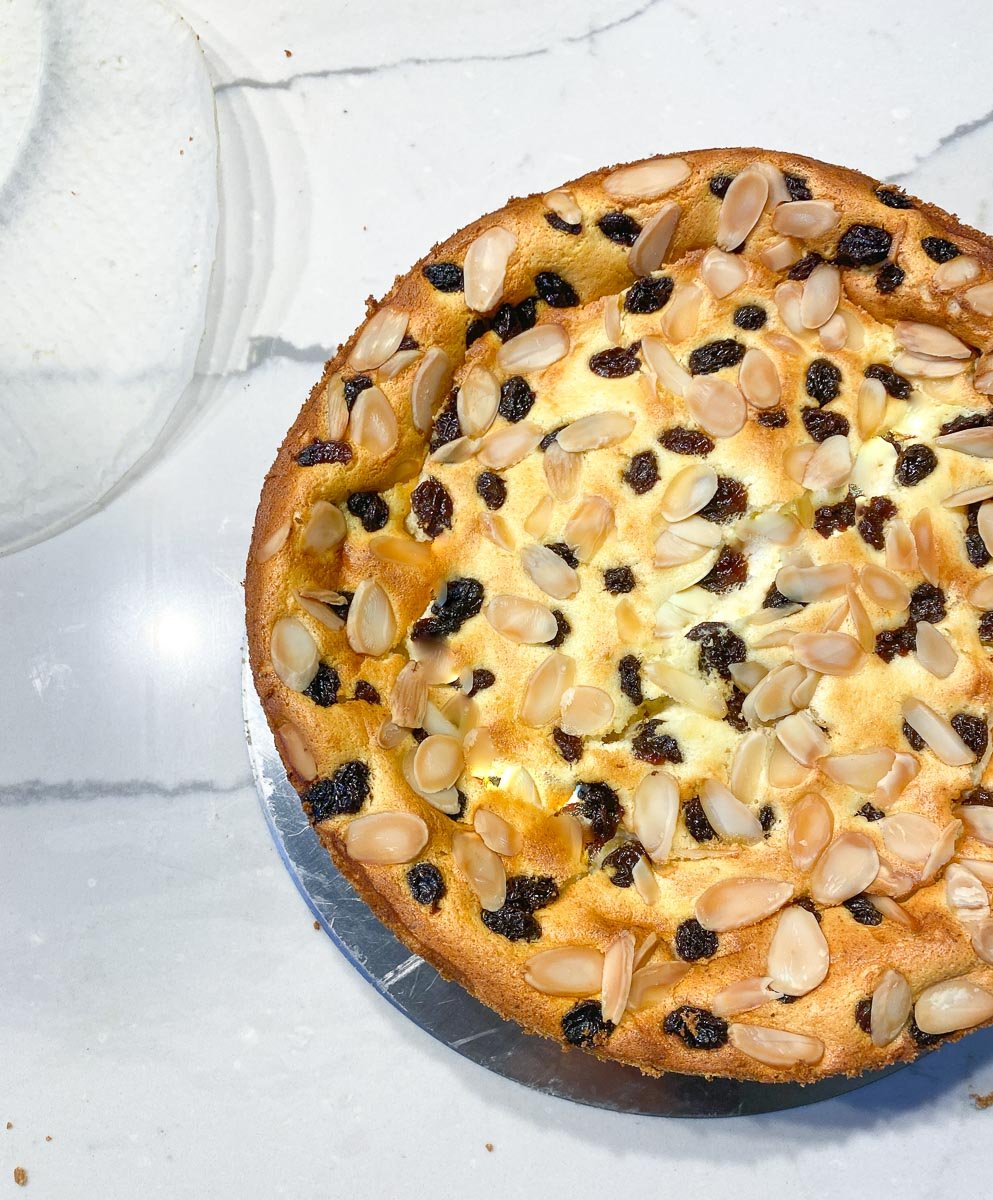
Serve the cake chilled, using a hot, wet knife to slice the cake into 14 wedges.
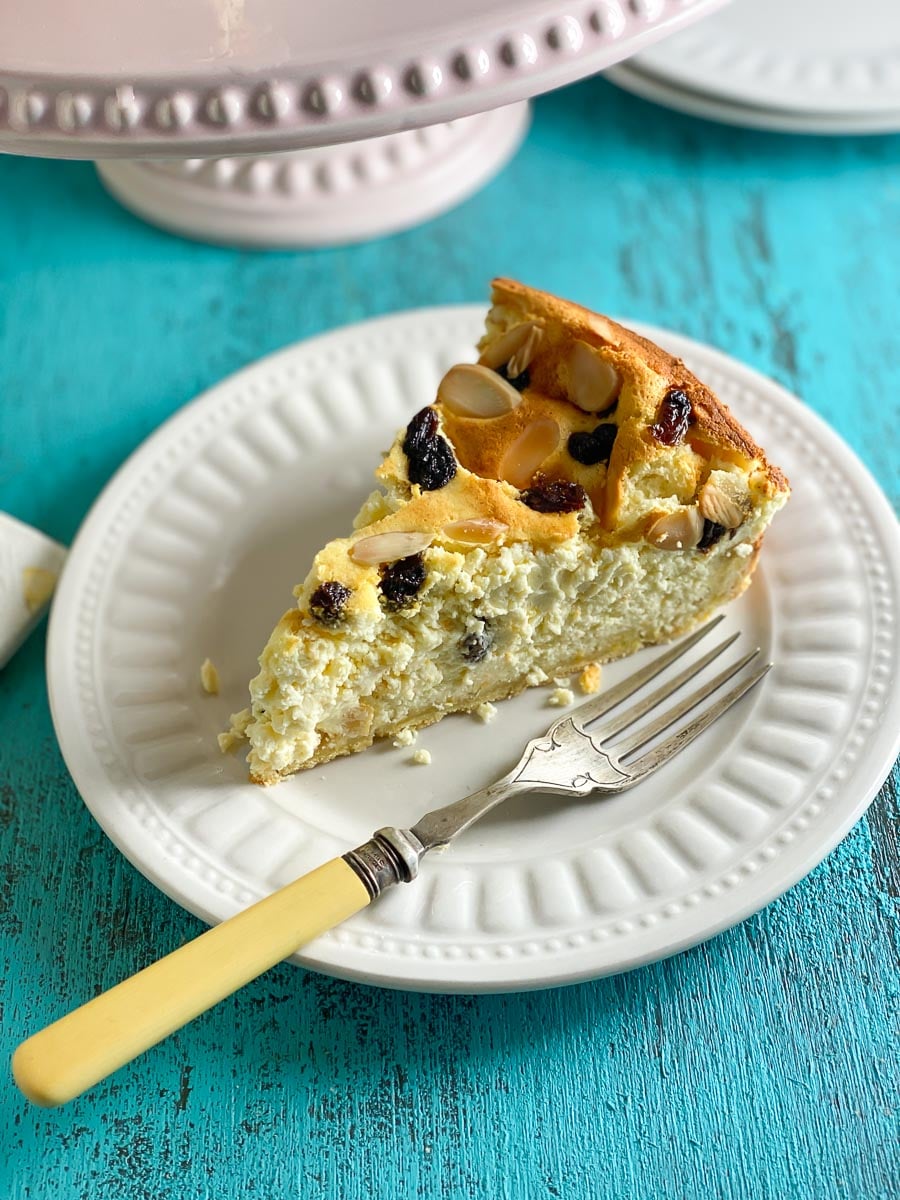
FODMAP Information
All recipes are based upon Monash University & FODMAP Friendly science at time of initial publication.
- Almonds: Both Monash University and FODMAP Friendly have lab tested whole almonds, and their results vary from one another. Monash says that a Green Light low FODMAP portion is 10 whole almonds at 12 g, but a high FODMAP portion is 20 whole almonds at 24 g. FODMAP Friendly gives them a “Pass” at 30 g or ¼ cup.
- Cheese: Many cheeses have low FODMAP serving sizes. The low FODMAP diet is not a dairy-free diet. Hard cheeses such as Parmigiano Reggiano or Pecorino Romano have been lab tested by Monash University and are low FODMAP in 40 g amounts.
- Dairy: The low FODMAP diet is not a dairy-free diet. It is, however, low in lactose. Many dairy ingredients are low in lactose, such as heavy cream and many cheeses.
- Eggs: Eggs are high in protein and do not contain carbohydrates, according to Monash University.
- Raisins: Monash and FODMAP Friendly have both lab tested raisins. While raw grapes contain no FODMAPs, the natural sugars concentrate upon drying and the resulting raisins do contain FODMAPs. Monash says a low FODMAP Green Light serving is 1 Australian tablespoon (13 g). FODMAP Friendly gives them a “Pass” at 3 tablespoons (30 g).
- Sugar: Monash University and FODMAP Friendly have both lab tested white, granulated sugar. Monash states that a Green Light low FODMAP serving size of white sugar is ¼ cup (50 g). FODMAP Friendly simply states that they have tested 1 tablespoon and that it is low FODMAP. Regular granulated white sugar is sucrose, which is a disaccharide made up of equal parts glucose and fructose. Sucrose is broken down and absorbed efficiently in the small intestine.
Please always refer to the Monash University & FODMAP Friendly smartphone apps for the most up-to-date lab tested information. Foods will be retested from time to time; in the case of raw ingredients, such as fruits and vegetables, results may vary. All lab tested results are valid and represent a snapshot in time. As always, your tolerance is what counts; please eat accordingly. The ultimate goal of the low FODMAP diet is to eat as broadly as possible, without triggering symptoms, for the healthiest microbiome.
More Cheese Cakes!
We assume you are a cheese cake lover! Be sure to check out these low FODMAP recipes as well.
- Chocolate Cheesecake
- New York Style Cheesecake with Strawberry Glaze
- Cheesecake Pie
- Cheesecake Brownies
- PB&J Cheesecake Brownies
- Lime Cheesecake Dip
- Frozen Peanut Butter Cheesecake
- Rhubarb Cheesecake Tart
- Pumpkin Cheesecake
- Cranberry Raspberry Cheesecake Trifle
- Espresso Cheesecake Brownies
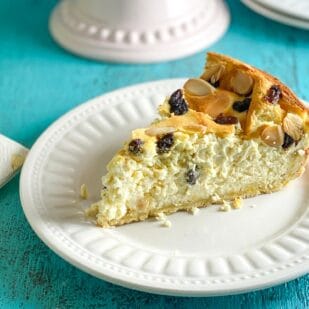
Low FODMAP Viennese Farmer Cheese Cake
Our Low FODMAP Viennese Farmer Cheese Cake is sometimes referred to as Topfentorte. (The farmer cheese – often spelled “farmer’s cheese” is “topfen”, a term also used to denote quark, another fresh cheese). This cheese cake is lighter than a NY-Style Cheesecake, features a pastry crust and flavors of citrus, almonds and plump, chewy raisins. Various versions abound, but this one is low FODMAP, using lactose-free dairy. You might need to source the farmer cheesebefore you head out to the market, so plan accordingly. Note that you do need a 9-inch (23 cm) springform pan and the cake is best chilled overnight before serving.
Ingredients:
Pastry Crust:
- ¾ cup (109 g) plus 2 tablespoons low FODMAP gluten-free all-purpose flour, such as Bob’s Red Mill 1 to 1 Gluten Free Baking Flour
- ¼ cup (50 g) sugar
- ¼ teaspoon xanthan gum
- Pinch salt
- 7 tablespoons (99 g) unsalted butter, at cool room temperature, cut into small pieces, plus extra
- 2 large egg yolks; save 1 egg white for the filling
- Grated zest of ½ lemon
- Grated zest of ½ orange; optional
- ¼ teaspoon vanilla extract
Cheese Cake Filling:
- 1- pound (455 g) farmer cheese, such as Friendship brand, at room temperature
- 1 cup (240 g) lactose-free sour cream, at room temperature
- ¾ cup (149 g) sugar, divided
- ¼ cup (60 ml) lactose-free whole milk; at room temperature, optional
- 2 tablespoons cornstarch
- 2 teaspoons vanilla extract
- Grated zest of ½ lemon
- Grated zest of ½ orange; optional
- ¼ teaspoon salt
- 4 large eggs; separated, plus 1 large egg white (saved from crust), at room temperature
- ¼ cup (22 g) sliced blanched almonds
- ¼ cup (52 g) plump raisins; plumped with 1 ½ tablespoons Grand Marnier as an option
Preparation:
-
For the Crust: Combine the flour, sugar, xanthan gum and salt in stand mixer bowl. Using the flat paddle attachment, add 7 tablespoons butter and mix on low-medium speed until the mixture resembles coarse crumbs. Whisk together the egg yolks, lemon zest, orange zest if using, and the vanilla extract and add to the dry mixture. Mix until the dough is evenly moistened and holds together when pressed between your fingers. Gather together by hand, knead it a couple of times, press into a flat disc and wrap with plastic wrap. Refrigerate for about 30 minutes. You can also make this dough this by hand with a pastry-blender. If you are short on time, I have successfully patted it into the prepped pan right away, with well-floured fingertips.
-
Position rack in lower third of oven. Preheat to 400°F (200°C). Line the bottom of a 9-inch (23 cm) springform pan with parchment paper as follows: Cut a piece of parchment larger than the pan’s bottom and place on top of pan bottom. Attach the springform sides so that they go over the paper and seal it into place as you snap the springform shut. The paper will overhang the exterior of the pan; that’s what you want. This will allow you to remove the cake from the pan bottom easily, to place on your serving platter.
-
Lightly butter the insides of the pan, both the parchment and pan’s sides. Press the dough firmly and evenly into the pan, bringing the dough about 1-inch (2.5 cm) up the sides. Pierce the dough all over with a fork and freeze for 10 minutes.
-
Bake for about 10 to 12 minutes or until the crust is just beginning to brown. Place on a wire rack and cool completely.
-
For the Filling: Place the farmer cheese into your stand mixer bowl, fitted with flat paddle attachment. Beat on medium speed for about 30 seconds; you want to smooth it out a bit. Add the sour cream, ¼ cup (50 g) of the sugar, milk (if using), cornstarch, vanilla, lemon zest, orange zest (if using), and salt and beat on low-medium speed until combined. Beat in the 4 egg yolks, one at a time; do not overmix. You want the batter to blended, but not to incorporate too much air, which could lead to excess expansion during baking, subsequent deflation and more chances of cracks forming.
-
Place egg whites in a clean, grease-free mixer bowl and beat with balloon whisk attachment on high speed until soft peaks form. Gradually add remaining ½ cup (99 g) of the sugar and beat until the egg whites form stiff, shiny peaks. Stir about a quarter of the whites into the cheese cake mixture to lighten, then fold in the rest. Pour the filling into the cooled crust and even out the top with a small offset spatula. Sprinkle the raisins (drained of any liquid) and almonds evenly over the top.
-
Bake for 10 minutes at 400°F (200°C), then reduce the oven temperature to 350°F (180°C) and bake for about 20 to 30 minutes more or until the edges of the filling are gently puffed and barely tinged with golden brown. The center will still be wobbly; it will firm up upon cooling. Do not overbake, which might encourage cracking.
-
Remove from the oven and place on a cooling to and cool completely. Cover the top with plastic wrap and refrigerate overnight or up to 2 days. To unmold, run a small, straight icing spatula under warm water and use it to completely separate the cake from the pan, pressing out towards the pan; remove springform sides. Now take a cake lifter, loose bottom tart pan bottom or broad flat spatula and separate the pastry crust from the parchment; lift cake up and away from parchment, peel away parchment, and place cake on serving platter. Serve the cake chilled, using a hot, wet knife to slice the cake into 14 wedges.
Notes:
FODMAP Information
Our recipes are based on Monash University and FODMAP Friendly science.
• Almonds: Both Monash University and FODMAP Friendly have lab tested whole almonds, and their results vary from one another. Monash says that a Green Light low FODMAP portion is 10 whole almonds at 12 g, but a high FODMAP portion is 20 whole almonds at 24 g. FODMAP Friendly gives them a “Pass” at 30 g or ¼ cup.
• Cheese: Many cheeses have low FODMAP serving sizes. The low FODMAP diet is not a dairy-free diet. Hard cheeses such as Parmigiano Reggiano or Pecorino Romano have been lab tested by Monash University and are low FODMAP in 40 g amounts.
• Dairy: The low FODMAP diet is not a dairy-free diet. It is, however, low in lactose. Many dairy ingredients are low in lactose, such as heavy cream and many cheeses.
• Eggs: Eggs are high in protein and do not contain carbohydrates, according to Monash University.
• Raisins: Monash and FODMAP Friendly have both lab tested raisins. While raw grapes contain no FODMAPs, the natural sugars concentrate upon drying and the resulting raisins do contain FODMAPs. Monash says a low FODMAP Green Light serving is 1 Australian tablespoon (13 g). FODMAP Friendly gives them a “Pass” at 3 tablespoons (30 g).
• Sugar: Monash University and FODMAP Friendly have both lab tested white, granulated sugar. Monash states that a Green Light low FODMAP serving size of white sugar is ¼ cup (50 g). FODMAP Friendly simply states that they have tested 1 tablespoon and that it is low FODMAP. Regular granulated white sugar is sucrose, which is a disaccharide made up of equal parts glucose and fructose. Sucrose is broken down and absorbed efficiently in the small intestine.
Please always refer to the Monash University & FODMAP Friendly smartphone apps for the most up-to-date lab tested information. Foods will be retested from time to time; in the case of raw ingredients, such as fruits and vegetables, results may vary. All lab tested results are valid and represent a snapshot in time. As always, your tolerance is what counts; please eat accordingly. The ultimate goal of the low FODMAP diet is to eat as broadly as possible, without triggering symptoms, for the healthiest microbiome.
Nutrition
All nutritional information is based on third-party calculations and should be considered estimates. Actual nutritional content will vary with brands used, measuring methods, portion sizes and more. For a more detailed explanation, please read our article Understanding The Nutrition Panel Within Our Recipes.
